TP Link Technologies WDN3200 N600 Wireless Dual Band USB Adapter User Manual User s manual FCC rev
TP-Link Technologies Co., Ltd. N600 Wireless Dual Band USB Adapter User s manual FCC rev
User's manual-FCC_rev
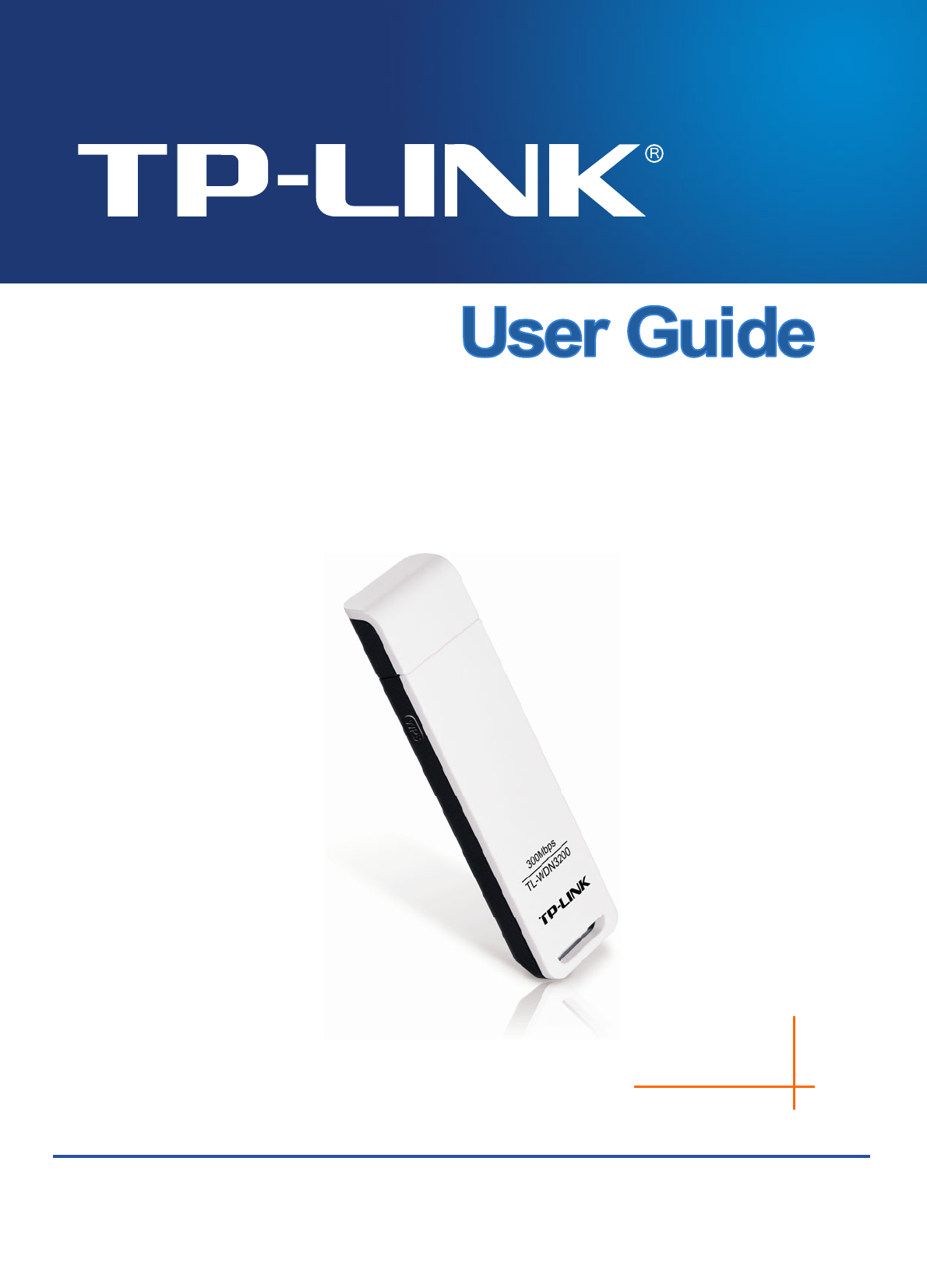
TL-WDN3200
N600 Wireless Dual Band USB Adapter
Rev: 1.0.0
1910010577

COPYRIGHT & TRADEMARKS
Specifications are subject to change without notice. is a registered trademark of
TP-LINK TECHNOLOGIES CO., LTD. Other brands and product names are trademarks or
registered trademarks of their respective holders.
No part of the specifications may be reproduced in any form or by any means or used to make
any derivative such as translation, transformation, or adaptation without permission from
TP-LINK TECHNOLOGIES CO., LTD. Copyright © 2012 TP-LINK TECHNOLOGIES CO., LTD.
All rights reserved.
http://www.tp-link.com

FCC STATEMENT
This equipment has been tested and found to comply with the limits for a Class B digital device,
pursuant to part 15 of the FCC Rules. These limits are designed to provide reasonable
protection against harmful interference in a residential installation. This equipment generates,
uses and can radiate radio frequency energy and, if not installed and used in accordance with
the instructions, may cause harmful interference to radio communications. However, there is no
guarantee that interference will not occur in a particular installation. If this equipment does
cause harmful interference to radio or television reception, which can be determined by turning
the equipment off and on, the user is encouraged to try to correct the interference by one or
more of the following measures:
• Reorient or relocate the receiving antenna.
• Increase the separation between the equipment and receiver.
• Connect the equipment into an outlet on a circuit different from that to which the
receiver is connected.
• Consult the dealer or an experienced radio/ TV technician for help.
This device complies with part 15 of the FCC Rules. Operation is subject to the following two
conditions:
1) This device may not cause harmful interference.
2) This device must accept any interference received, including interference that may cause
undesired operation.
Any changes or modifications not expressly approved by the party responsible for compliance
could void the user’s authority to operate the equipment.
Note: The manufacturer is not responsible for any radio or tv interference caused by
unauthorized modifications to this equipment. Such modifications could void the user’s authority
to operate the equipment.
FCC RF Radiation Exposure Statement:
This equipment complies with FCC radiation exposure limits set forth for an uncontrolled
environment. End users must follow the specific operating instructions for satisfying RF
exposure compliance. This transmitter must not be co-located or operating in conjunction with
any other antenna or transmitter. This equipment has been SAR-evaluated for use in hand.
SAR measurements are based on a 5mm spacing from the body and that compliance is
achieved at that distance.

CE Mark Warning
This is a class B product. In a domestic environment, this product may cause radio interference,
in which case the user may be required to take adequate measures.
National Restrictions
This device is intended for home and office use in all EU countries (and other countries
following the EU directive 1999/5/EC) without any limitation except for the countries mentioned
below:
Country Restriction Reason/remark
Bulgaria None General authorization required for outdoor use and
public service
France
Outdoor use limited to
10 mW e.i.r.p. within
the band 2454-2483.5
MHz
Military Radiolocation use. Refarming of the 2.4 GHz
band has been ongoing in recent years to allow current
relaxed regulation. Full implementation planned 2012
Italy None If used outside of own premises, general authorization is
required
Luxembourg None General authorization required for network and service
supply(not for spectrum)
Norway Implemented This subsection does not apply for the geographical area
within a radius of 20 km from the centre of Ny-Ålesund
Russian Federation None Only for indoor applications
Note: Please don’t use the product outdoors in France.

Industry Canada Statement:
This device complies with RSS-210 of the Industry Canada Rules. Operation is subject to the
following two conditions:
(1)This device may not cause harmful interference, and
(2)This device must accept any interference received, including interference that may cause
undesired operation.
Ce dispositif est conforme à la norme CNR-210 d’Industrie Canada applicable aux appareils
radio exempts de licence. Son fonctionnement est sujet aux deux conditions suivantes:
(1) Le dispositif ne doit pas produire de brouillage préjudiciable, et
(2) Ce dispositif doit accepter tout brouillage reçu,y compris un brouillage susceptible de
provoquer un fonctionnement indésirable.
Korea Warning Statements:
당해 무선설비는 운용중 전파혼신 가능성이 있음.
NCC Notice:
經型式認證合格之低功率射頻電機,非經許可,公司、商號或使用者均不得擅自變更頻率、加大
功率或變更原設計之特性及功能。
低功率射頻電機之使用不得影響飛航安全及干擾合法通信;經發現有干擾現象時,應立即停用,
並改善至無干擾時方得繼續使用。前項合法通信,指依電信法規定作業之無線電通信。低功率射
頻電機須忍受合法通信或工業、科學及醫療用電波輻射性電機設備之干擾。
如有這頻率:
於5.25GHz至5.35GHz區域內操作之無線設備的警告聲明
工作頻率 5.250~5.350GHz 該頻段限於室內使用。
This Class B digital apparatus complies with Canadian ICES-003.
Cet appareil numérique de la classe B est conforme à la norme NMB-003 du Canada.
Safety Information
� When product has power button, the power button is one of the way to shut off the
product; When there is no power button, the only way to completely shut off power is to
disconnect the product or the power adapter from the power source.
� Don’t disassemble the product, or make repairs yourself. You run the risk of electric
shock and voiding the limited warranty. If you need service, please contact us.
� Avoid water and wet locations.
� This is a domestic product, and please make sure of the indoor use.

TP-LINK TECHNOLOGIES CO., LTD
TP-LINK TECHNOLOGIES CO., LTD.
Building 24 (floors 1, 3, 4, 5), and 28 (floors 1-4) Central Science and Technology Park,
Shennan Rd, Nanshan, Shenzhen, China
DECLARATION OF CONFORMITY
For the following equipment:
Product Description: N600 Wireless Dual Band USB Adapter
Model No.: TL-WDN3200
Trademark: TP-LINK
We declare under our own responsibility that the above products satisfy all the technical
regulations applicable to the product within the scope of Council Directives:
Directives 1999/5/EC, Directives 2006/95/EC, Directives1999/519/EC, Directives 2011/65/EU
The above product is in conformity with the following standards or other normative documents:
ETSI EN 300 328 V1.7.1: 2006
ETSI EN 301 489-1 V1.8.1:2008 & ETSI EN 301 489-17 V2.1.1:2009
EN60950-1:2006+A11:2009+A1:2010
EN62311:2008
EN 301 893
The product carries the CE Mark:
Person is responsible for marking this declaration:
Yang Hongliang
Product Manager of International Business
Date of issue: 2012
CONTENTS
Package Contents .................................................................................................... 1
Chapter 1 Product Overview ................................................................................. 2
1.1 Introduction ............................................................................................................. 2
1.2 Features.................................................................................................................. 2
1.3 Hardware Overview................................................................................................. 3
Chapter 2 Installation............................................................................................. 4
2.1 Hardware Installation .............................................................................................. 4
2.2 Software Installation................................................................................................ 4
Chapter 3 Connect to a Wireless Network ........................................................... 9
3.1 To connect using TWCU ......................................................................................... 9
3.2 To connect using WPS.......................................................................................... 12
3.2.1 PBC (Push Button Configuration) method................................................ 12
3.2.2 PIN method .............................................................................................. 14
3.2.2.1. Enter the PIN from your AP device ............................................................................14
3.2.2.2. Enter a PIN into your AP device.................................................................................15
3.3 To connect using Windows built-in wireless utility................................................. 17
3.3.1 In Windows 7............................................................................................ 17
3.3.2 In Windows Vista...................................................................................... 18
3.3.3 In Windows XP......................................................................................... 20
Chapter 4 Management........................................................................................ 23
4.1 Profile.................................................................................................................... 23
4.1.1 Add a profile ............................................................................................. 23
4.1.1.1. Add a profile in Infrastructure mode ...........................................................................23
4.1.1.2. Add a profile in ad-hoc mode .....................................................................................25
4.1.2 Modify a profile......................................................................................... 27
4.1.3 Delete a profile ......................................................................................... 27
4.2 Advanced .............................................................................................................. 28
4.3 About..................................................................................................................... 29
Chapter 5 AP Mode .............................................................................................. 30
Chapter 6 Uninstall Software............................................................................... 33
6.1 Uninstall the utility software from your PC............................................................. 33
6.2 Uninstall the driver software from your PC............................................................ 34
Appendix A: Specifications................................................................................... 36
Appendix B: Glossary............................................................................................ 37

TL-WDN3200 N600 Wireless Dual Band USB Adapter
1
Package Contents
Please verify that all the package contents below are available.
¾ One TL-WDN3200 N600 Wireless Dual Band USB Adapter
¾ Quick Installation Guide
¾ USB cable
¾ One Resource CD for TL-WDN3200, including:
• TP-LINK Wireless Configuration Utility (TWCU) and Drivers
• User Guide
• Other helpful information
Make sure that the above items are contained in the package. If any of the above items are
damaged or missing, please contact your distributor.
) Note:
The ‘adapter’ mentioned in this User Guide stands for TL-WDN3200 N600 Wireless Dual Band
USB Adapter without any explanations.

TL-WDN3200 N600 Wireless Dual Band USB Adapter
2
Chapter 1
Product Overview
1.1 Introduction
The adapter is a 802.11n client device designed to deliver a high-speed and unrivaled wireless
performance for your desktop. It has better speed and range with less interference compared to
other wireless-N adapters, thus you can get a better Internet experience, such as downloading,
online gaming, Internet phone calls and video streaming.
With the 802.11n technology, higher throughput improvements using 2T2R, the TL-WDN3200’s
auto-sensing capability allows high packet transfer rate of up to 300Mbps for maximum
throughput. It has good capability on anti-jamming, and it can also interoperate with other wireless
(802.11b) products. The adapter supports WEP, WPA and WPA2 encryption to prevent outside
intrusion and protect your personal information from being exposed.
The adapter is easy to install and manage with the Quick Setup Wizard guiding you step-by-step
through the installation process and the TP-LINK Wireless Configuration Utility instructing you to
quickly set up a wireless connection.
With unmatched wireless performance, reception, and security protection, the TL-WDN3200 is
the best choice for easily adding or upgrading wireless connectivity to your desktop.
1.2 Features
¾ Complies with IEEE802.11a, IEEE802.11n, IEEE802.11g, IEEE802.11b standards
¾ Supports WPA-PSK/WPA2-PSK, WPA/WPA2 data security, TKIP/AES encryption, WEP
encryption
¾ Supports high rate of up to 300Mbps for maximum throughput, supports automatically
adjust to lower speeds due to distance or other operating limitations
¾ Provides USB 2.0 interface
¾ Supports Ad-Hoc and Infrastructure modes
¾ Good capability on anti-jamming
¾ Supports roaming between access points when configured in Infrastructure mode
¾ Ease to configure and provides monitoring information
¾ Supports Windows 7, Windows Vista, and Windows XP

TL-WDN3200 N600 Wireless Dual Band USB Adapter
3
1.3 Hardware Overview
LED status:
Status Working Status
On The adapter has connected to a network. .
Flashing Slowly The driver has been installed but no data is being transmitted or
received.
Flashing Quickly Data is being transmitted or received.
)Note:
When the adapter failed to connect to a wireless network, the LED may be off. Please choose
your network and try to connect again.
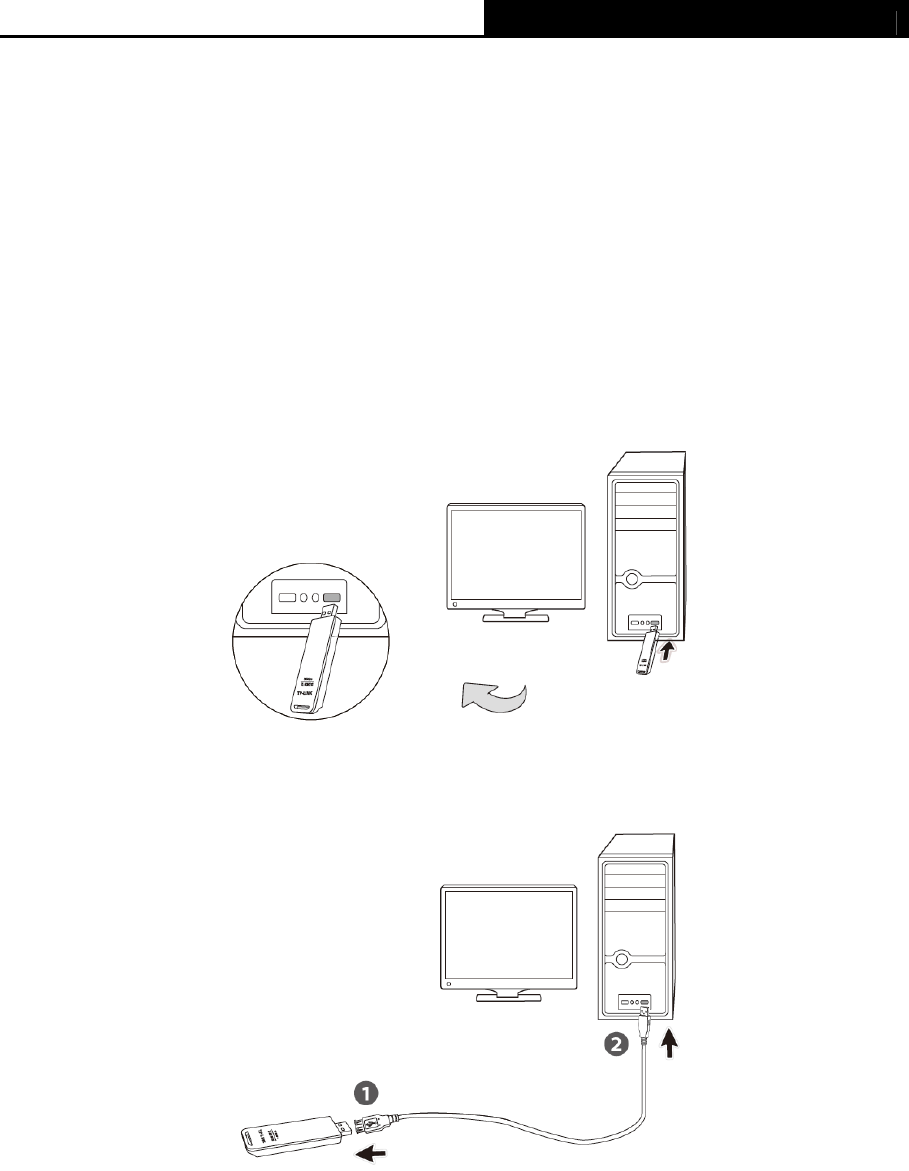
TL-WDN3200 N600 Wireless Dual Band USB Adapter
4
Chapter 2 Installation
Please insert the USB adapter into your computer before installing the driver software from the
Resource CD.
2.1 Hardware Installation
There are two methods:
Method One:
Plug the adapter into an available USB interface on your computer directly.
Method Two:
Connect the adapter and your computer with the provided USB cable.
When the Found New Hardware wizard appears, click Cancel.
2.2 Software Installation
The adapter’s Setup Wizard will guide you through the installation procedures for Windows 7,
Windows Vista, and Windows XP. The procedures in different systems are quite similar,
therefore here takes the procedures in Windows 7 for example.
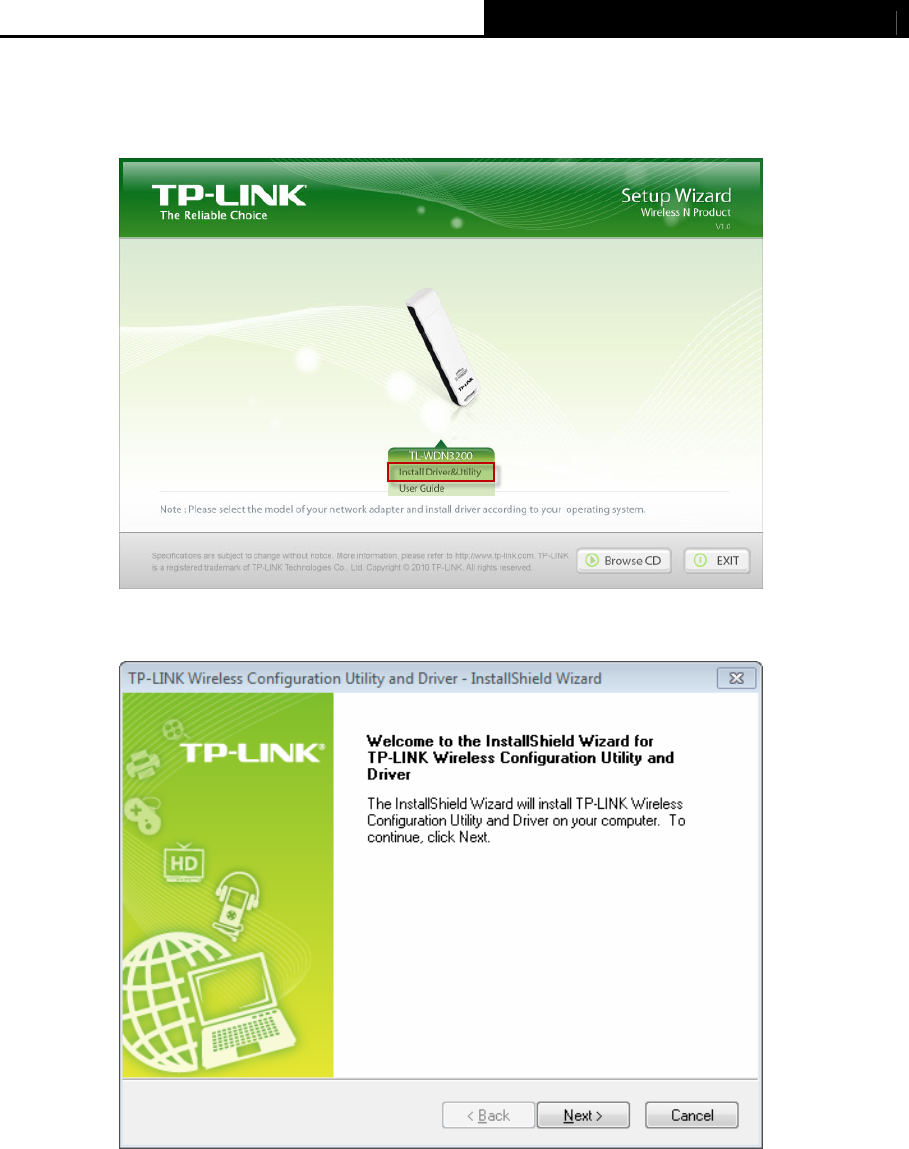
TL-WDN3200 N600 Wireless Dual Band USB Adapter
5
1. Insert the Resource CD into your CD-ROM drive, and the window below will appear. Select
model TL-WDN3200. There will be a menu including: Install Driver&Utility and User
Guide. Click Install Driver&Utility to begin.
Figure 2-1
2. The InstallShield Wizard window will appear. Click Next to continue.
Figure 2-2
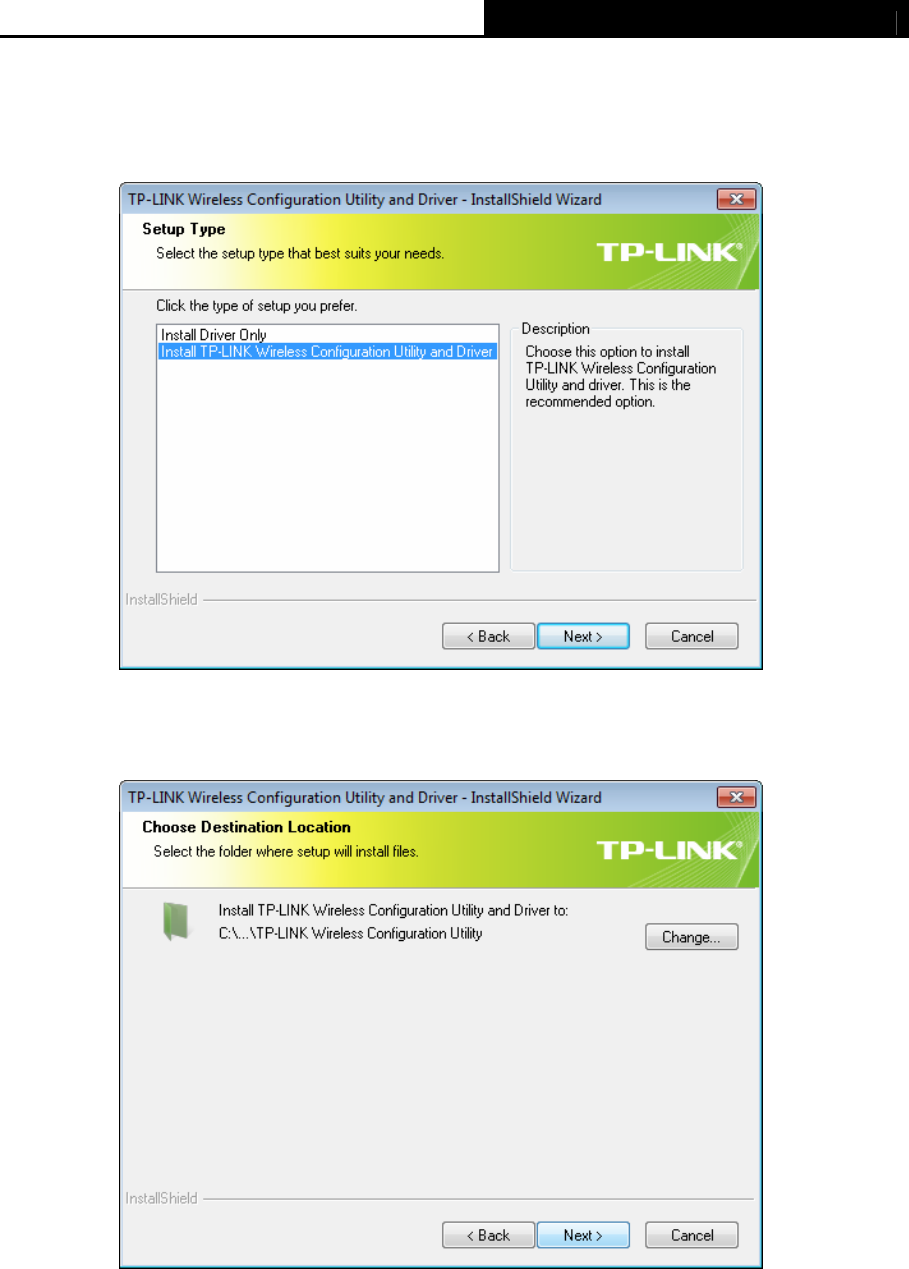
TL-WDN3200 N600 Wireless Dual Band USB Adapter
6
3. Choose a setup type. It is recommended to select Install TP-LINK Wireless
Configuration Utility and Driver. Selecting Install Driver Only will only install driver and
you will not be able to manage the networks through TP-LINK configuration utility. Click
Next to continue.
Figure 2-3
4. Click Change to specify the destination location for the software or you can leave it default.
Click Next in the screen below to continue.
Figure 2-4
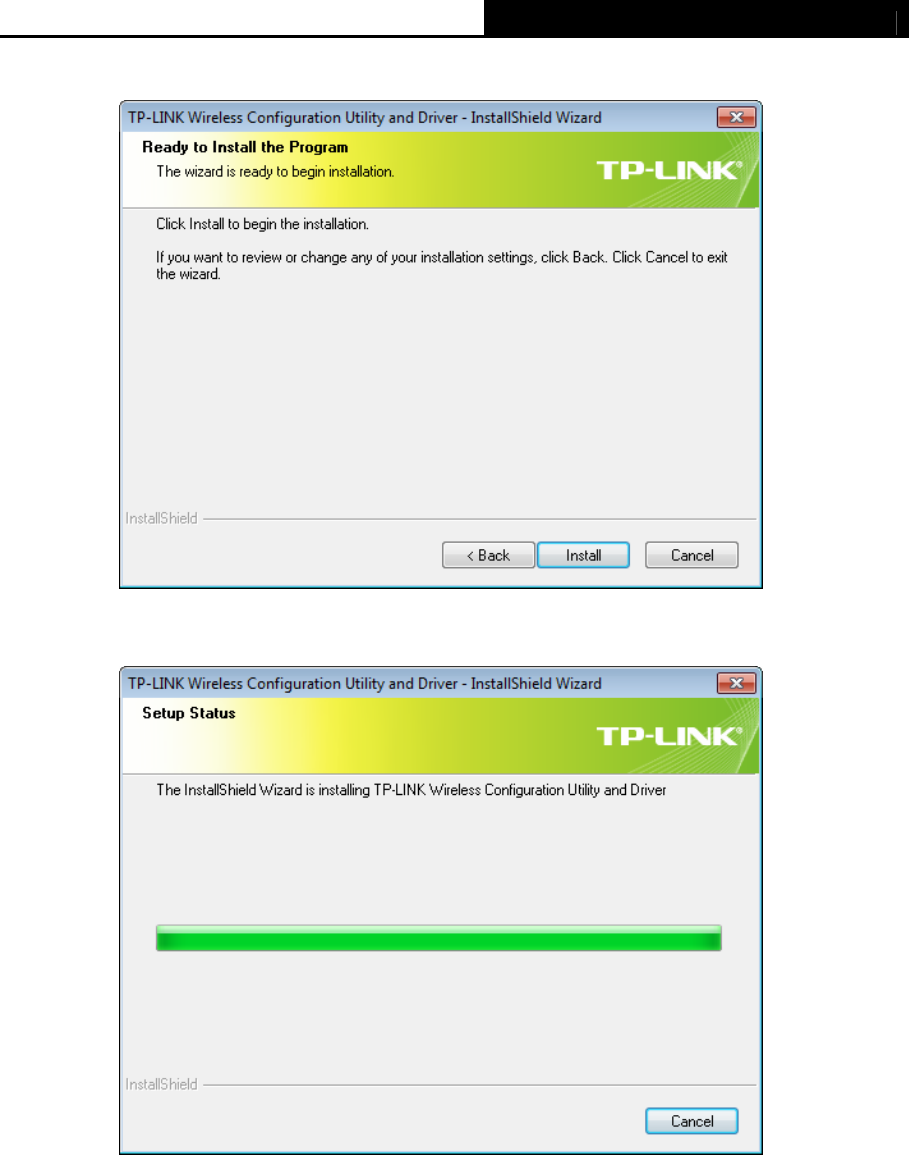
TL-WDN3200 N600 Wireless Dual Band USB Adapter
7
5. Click Install to continue the setup.
Figure 2-5
6. The utility and drivers will install. This may take 1~2 minutes.
Figure 2-6
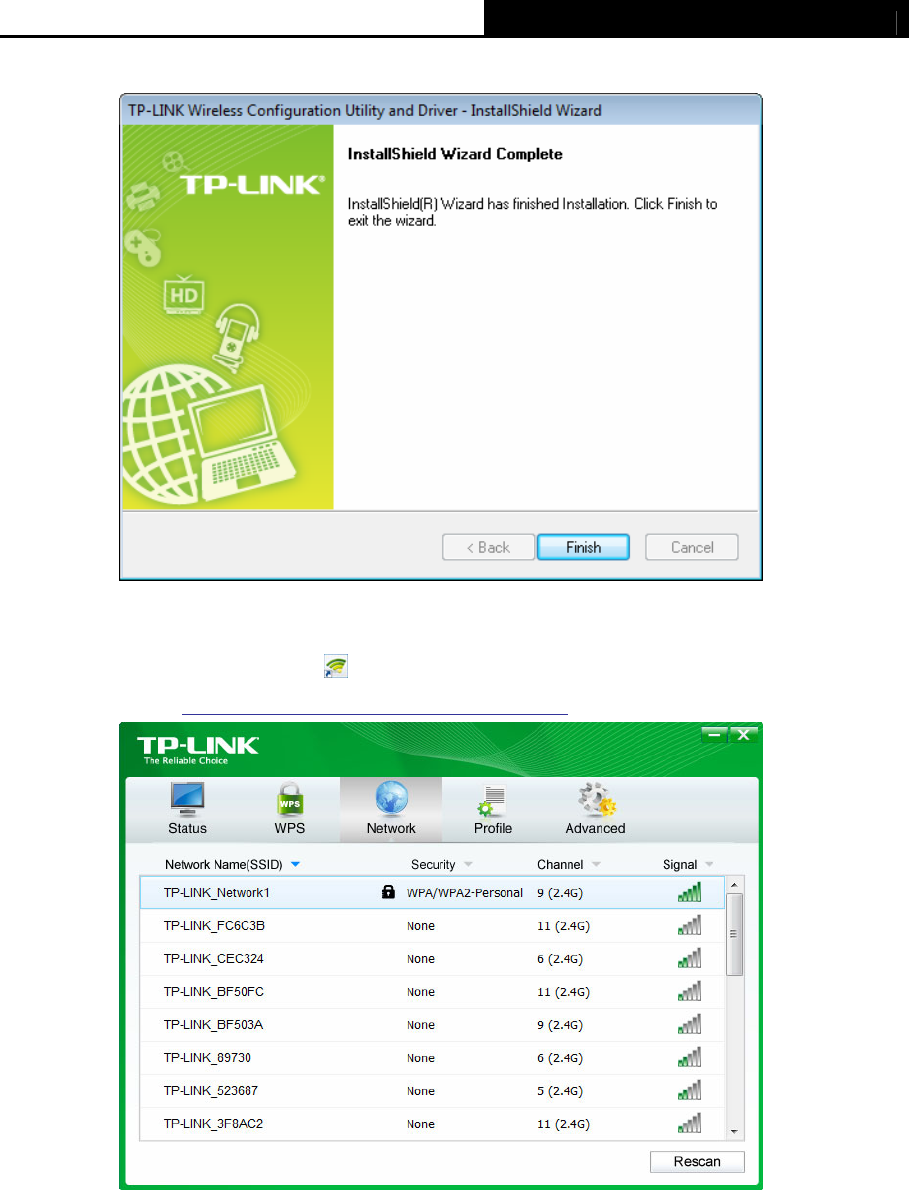
TL-WDN3200 N600 Wireless Dual Band USB Adapter
8
7. After all the steps above, you will see the screen below. Click Finish to complete the setup.
Figure 2-7
8. After installation, the utility configuration page will automatically pop up as shown in the
following figure and the icon will appear on your desktop. To connect to a network,
please refer to Chapter 3 Connect to a Wireless Network.
Figure 2-8
)Note:
If you have only installed the driver, the above configuration page will not pop up. You need to
use the Windows built-in wireless utility to connect to and manage your network.
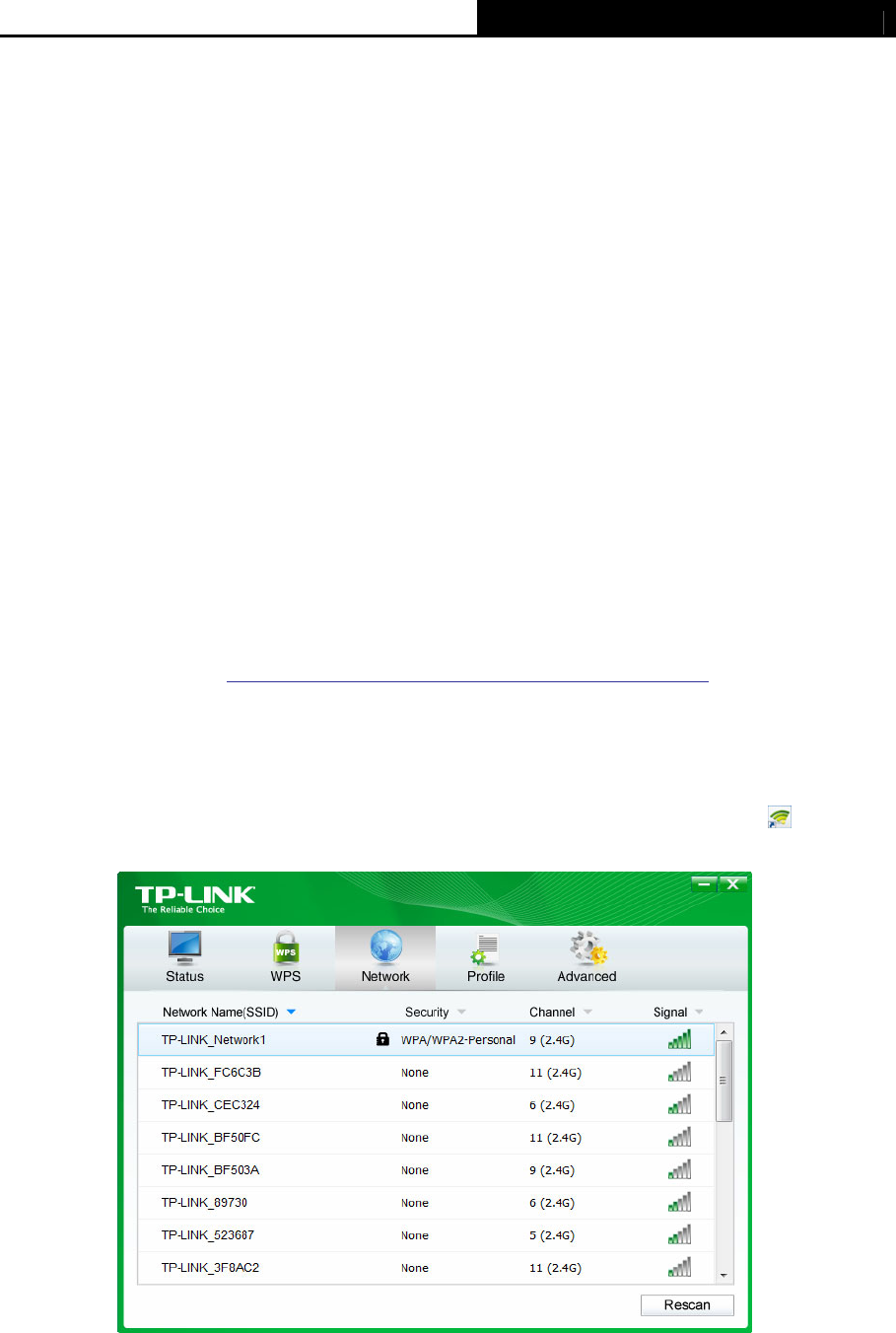
TL-WDN3200 N600 Wireless Dual Band USB Adapter
9
Chapter 3 Connect to a Wireless Network
With both the hardware and software successfully installed into your computer, you can quickly
connect to a wireless network using one of the following methods.
¾ Method One:
To connect using TWCU
TL-WDN3200 uses the TP-LINK Wireless Configuration Utility as the management software.
The utility provides you an easy interface to connect to a network and to change any settings
related to the wireless adapter.
¾ Method Two:
To connect using WPS
Just by pushing the WPS button, you can set up a wireless connection quickly under the
condition that your router or access point supports WPS (also called QSS).
¾ Method Three:
To connect using Windows built-in wireless utility
Windows users may use the built-in wireless utility to connect to a wireless network. For specific
operations, please go to 3.3 To connect using Windows built-in wireless utility.
3.1 To connect using TWCU
1. After installation, the utility configuration page will automatically pop up on the screen. If the
utility page does not pop up, you can launch the utility by double-clicking the icon on
your desktop.
Figure 3-1
2. The Network page will display all wireless networks that are available in your area. To
connect to a network, simply select the wireless network name and click Connect.
SSID (Service Set Identifier) is the name of the wireless network. The adapter will
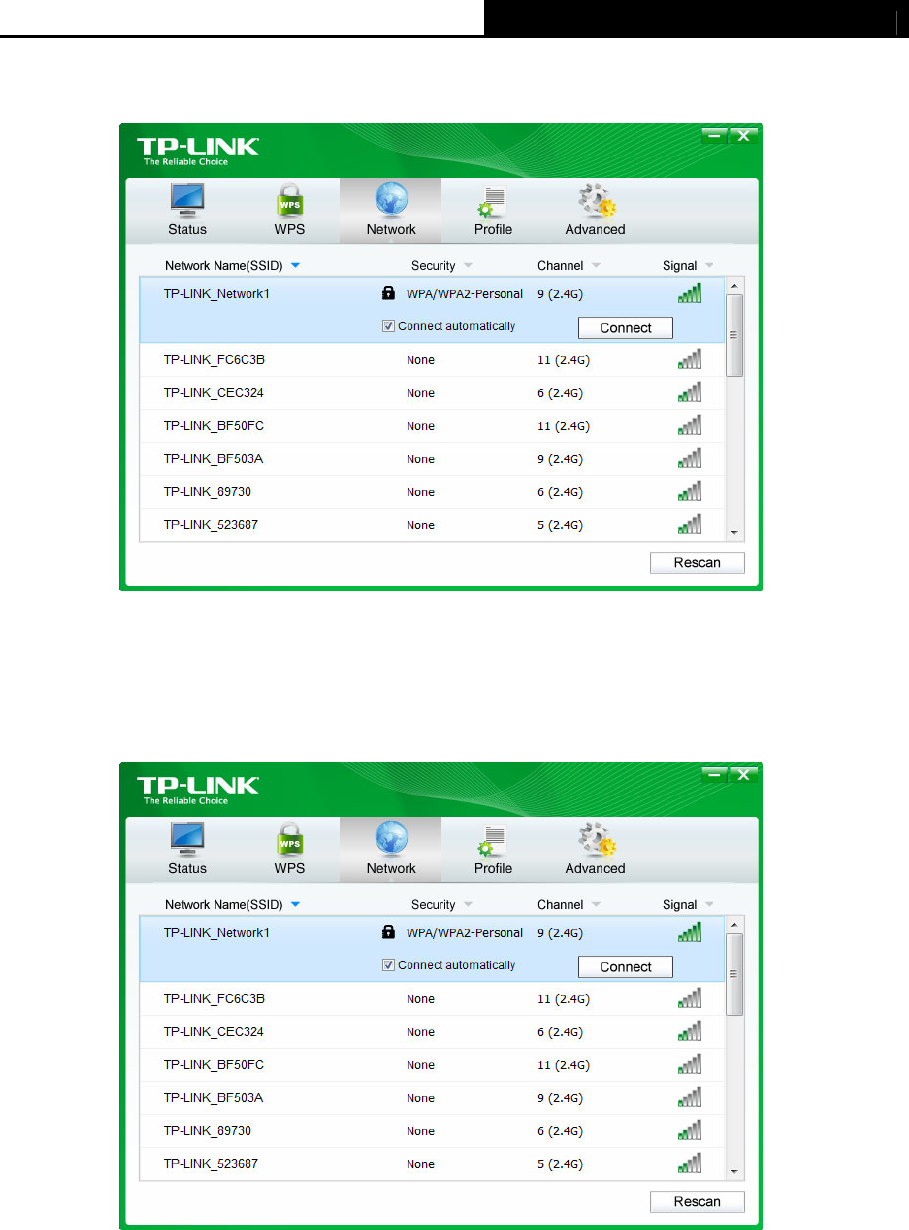
TL-WDN3200 N600 Wireless Dual Band USB Adapter
10
automatically connect to your target network next time and automatically save it as a profile
if you tick Connect automatically.
Figure 3-2
3. If word None appears behind the SSID, this means the network to be connected is not
security-enabled and you can connect to the network without entering a key. To prevent
outside intrusion and safeguard your network, it is strongly recommended that you set a
password to your router or access point.
Figure 3-3
If there is a “lock” icon behind the SSID, this means the wireless network is secure and the
corresponding security type will display. You must know the encryption key/security
settings to connect.
Input the password which can be found on the configuration page of your router or access
point, then click OK to continue. Or push the WPS / QSS button on your router if your
router features the WPS / QSS function to quickly build a connection without having to
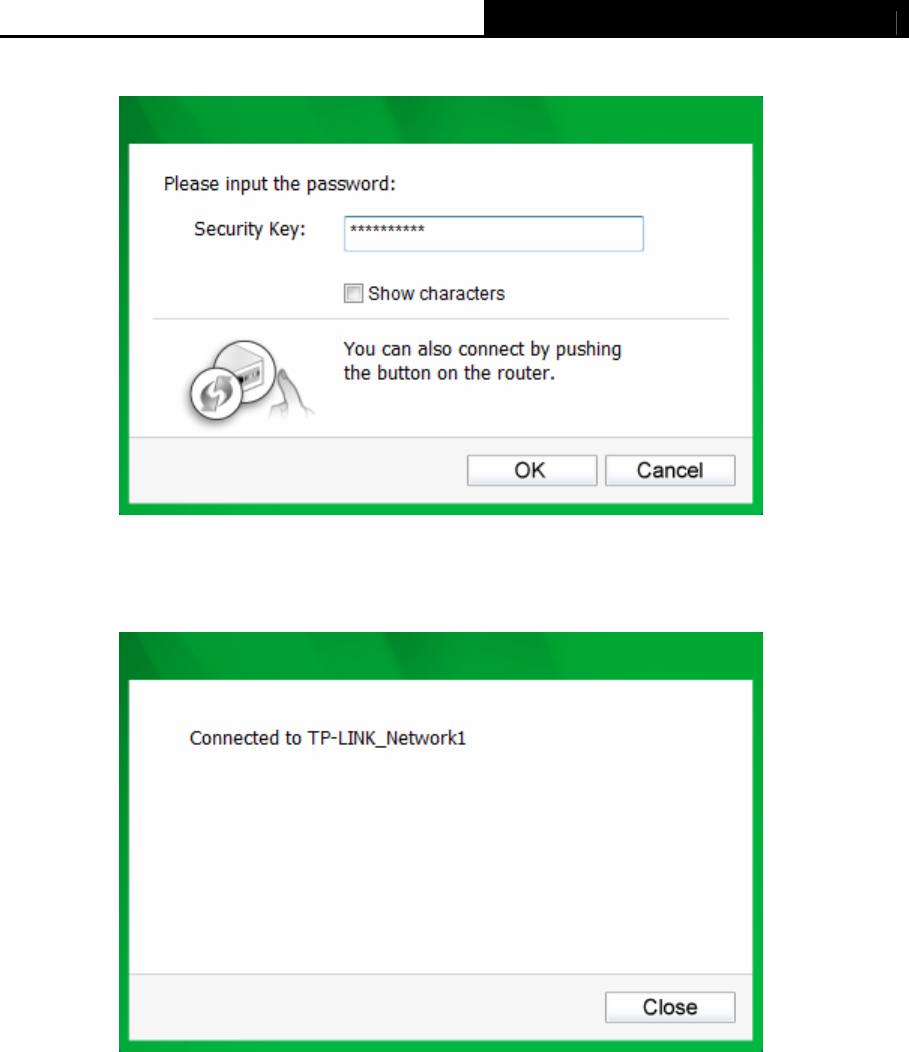
TL-WDN3200 N600 Wireless Dual Band USB Adapter
11
enter a key.
Figure 3-4
4. You have successfully connected to your network and can surf the Internet now. Click
Close to enjoy the Internet.
Figure 3-5
5. To view more information about the network currently connected, click Status in the tools
section and the page will display information such as the network type, link quality and
wireless mode.
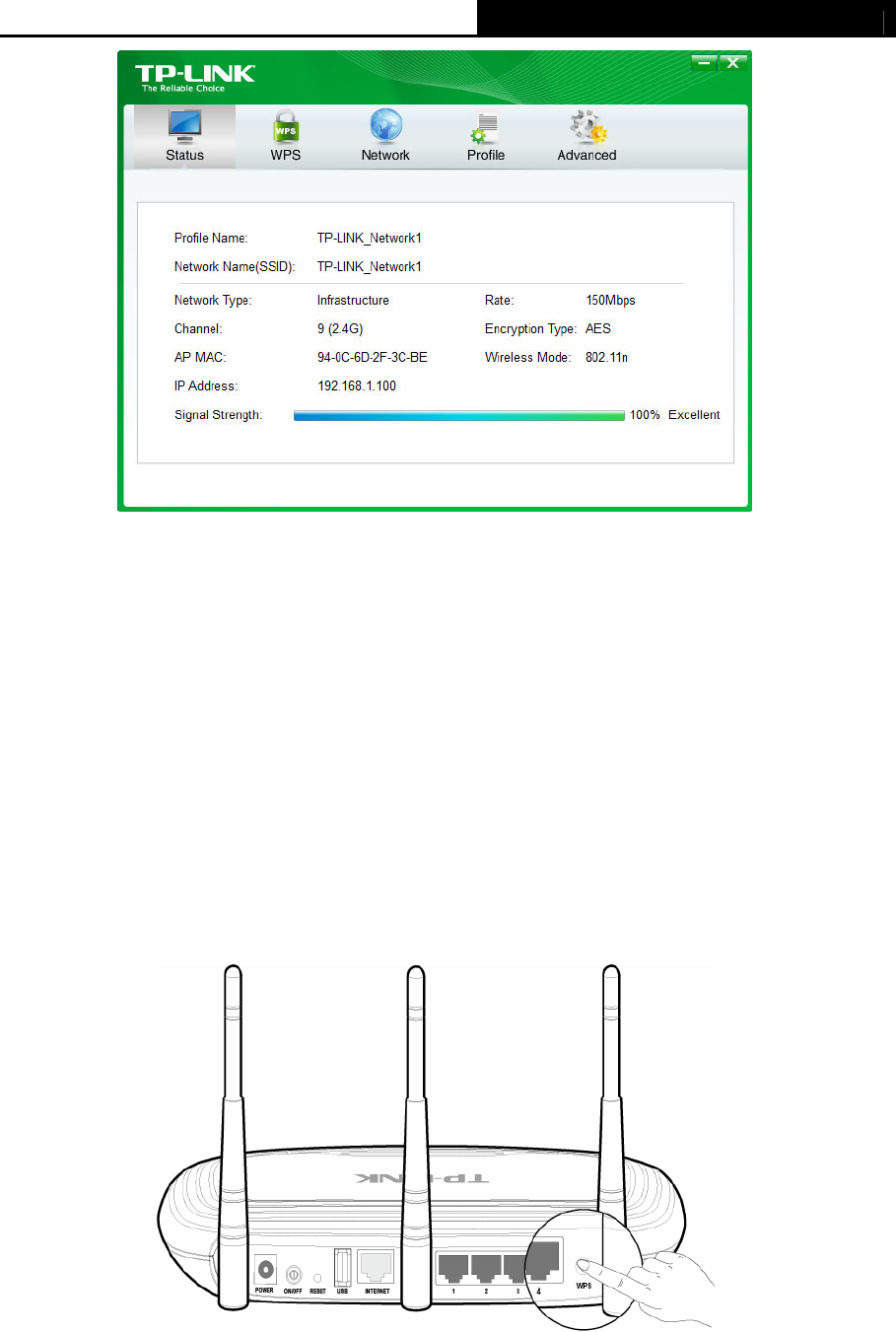
TL-WDN3200 N600 Wireless Dual Band USB Adapter
12
Figure 3-6
3.2 To connect using WPS
WPS (Wi-Fi Protected Setup) function allows you to add a new wireless device to an existing
network quickly.
If the wireless router supports WPS or QSS (Quick Secure Setup), you can establish a wireless
connection between wireless card and router using either Push Button Configuration (PBC)
method or PIN method. Three WPS connection methods are listed in the following parts.
3.2.1 PBC (Push Button Configuration) method
1. Press the WPS button on the back panel of the router. Here takes router TL-WR2543ND
for example.
Figure 3-7
2. Press the WPS button on the adapter. There are two ways:
1) Press and hold the WPS button on the adapter directly for 2~3 seconds until Figure
3-9 appears.
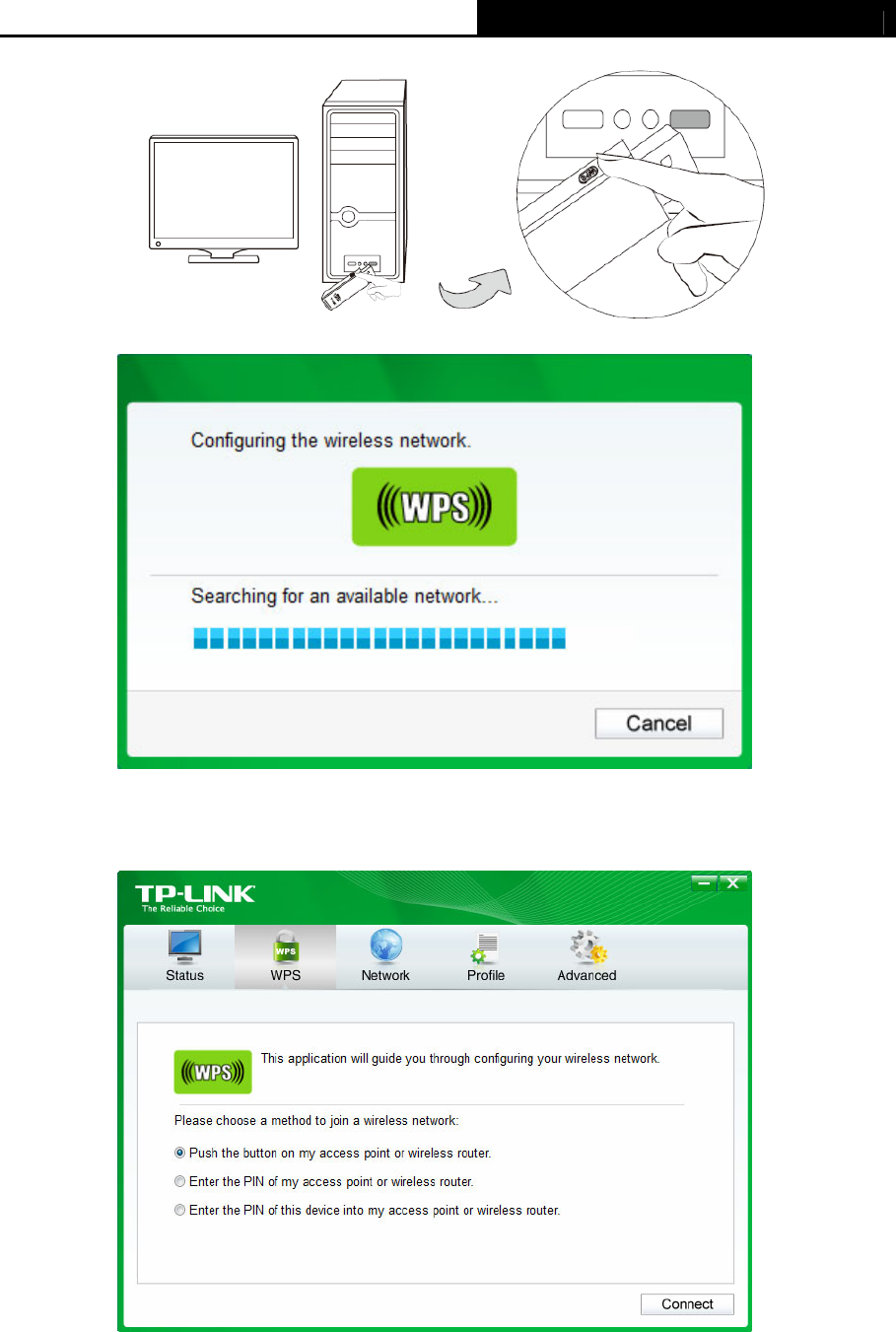
TL-WDN3200 N600 Wireless Dual Band USB Adapter
13
Figure 3-8
Figure 3-9
2) Open TWCU and click WPS tab. Select Push the button on my access point or
wireless router and then click Connect.
Figure 3-10
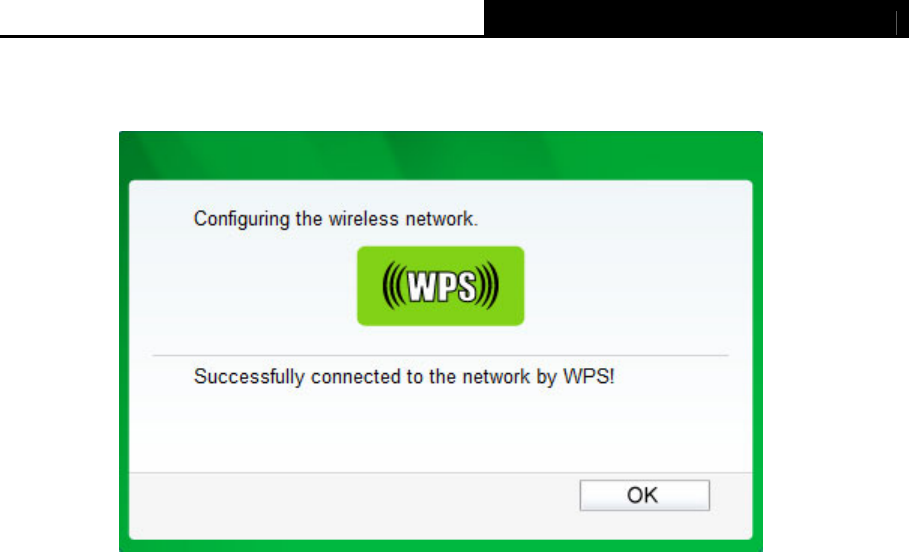
TL-WDN3200 N600 Wireless Dual Band USB Adapter
14
3. When the following window appears, you have successfully connected to the network.
Click OK to finish the WPS connection.
Figure 3-11
3.2.2 PIN method
There are two ways to configure the WPS by PIN method:
1) Enter the PIN from your AP device.
2) Enter a PIN into your AP device.
Following are detailed configuration procedures of each way.
3.2.2.1. Enter the PIN from your AP device
1. Open TWCU and click WPS tab. Select Enter the PIN of my access point or wireless
router. In the empty field beside PIN, enter the PIN labeled on the bottom of the router
(here takes 13492564 for example). If you have generated a new PIN code for your router,
please enter the new one instead. Click Connect to continue.
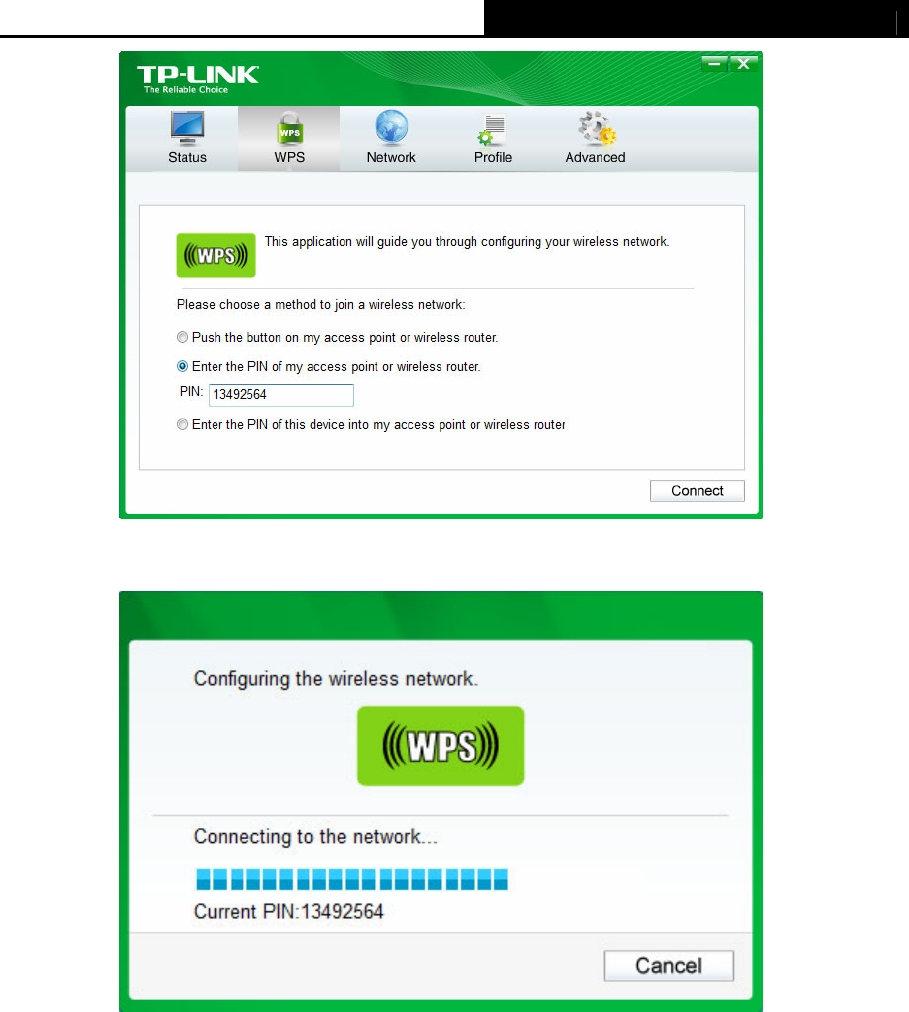
TL-WDN3200 N600 Wireless Dual Band USB Adapter
15
Figure 3-12
2. The adapter will be connecting to the target network.
Figure 3-13
3. When Figure 3-11 appears, you have successfully connected to the network.
3.2.2.2. Enter a PIN into your AP device
1. Open TWCU and click WPS tab. Select Enter the PIN of this device into my access
point or wireless router. In the field beside PIN, you will see the PIN value of the adapter
which is randomly generated. Click Connect to continue.
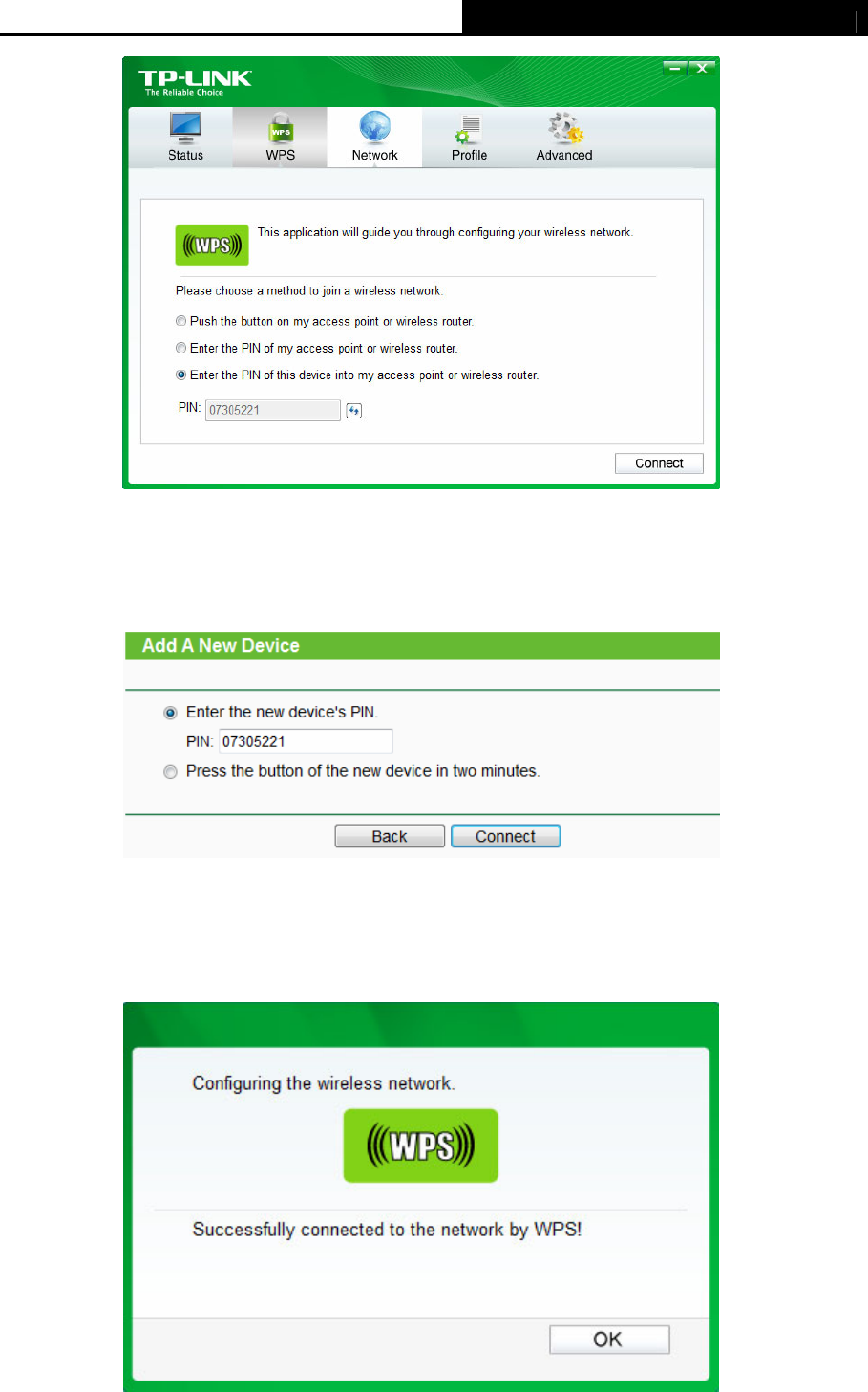
TL-WDN3200 N600 Wireless Dual Band USB Adapter
16
Figure 3-14
2. Open your router’s Web-based Utility and click WPS link on the left of the main menu. Then
click “Add device” and the following figure will appear. Enter the PIN value of the adapter in
the empty field beside PIN and then click Connect.
Figure 3-15
3. When Connect successfully appears on the screen, the WPS configuration is complete.
Or you can view the adapter’s utility page to see whether the connection has been
successful as shown in Figure 3-16.
Figure 3-16
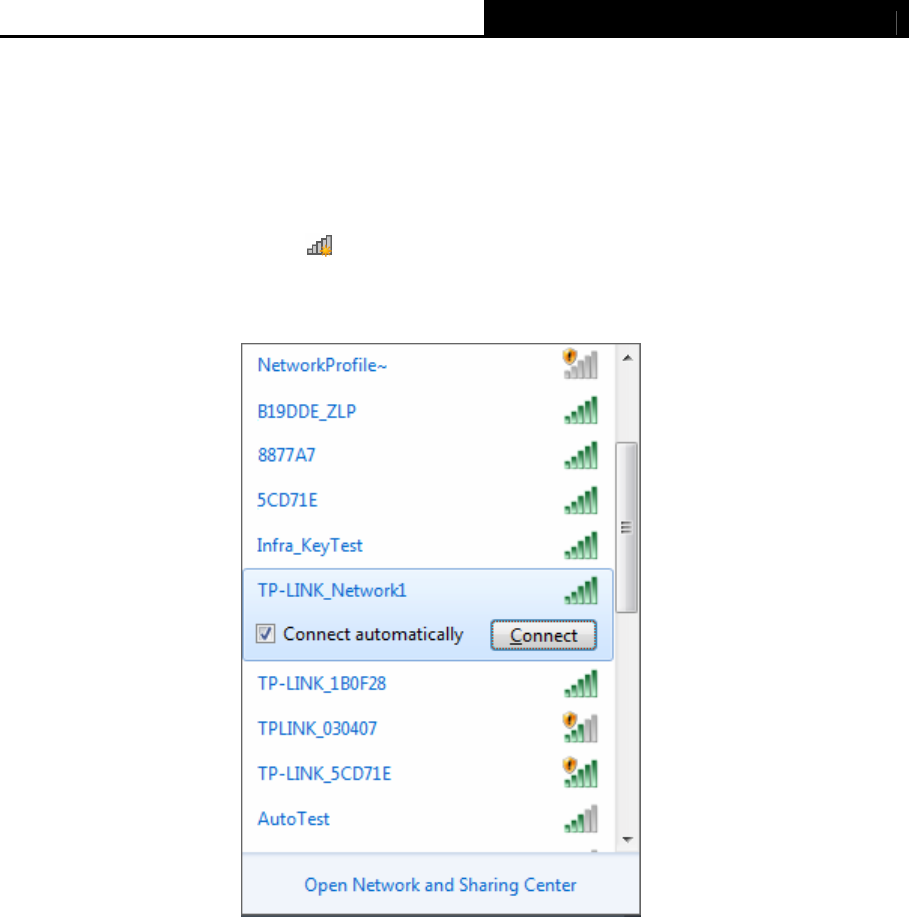
TL-WDN3200 N600 Wireless Dual Band USB Adapter
17
3.3 To connect using Windows built-in wireless utility
3.3.1 In Windows 7
Windows 7 users may use the built-in wireless utility. Follow the steps below.
1. Left-click the wireless icon in your system tray (lower-right corner) as shown in the
figure below. The utility will display any available wireless networks in your area. Select the
wireless network (displayed using the SSID) to be connected and then click Connect.
Figure 3-17
2. If the network you would like to connect is security-enabled, enter the same security key or
passphrase that is on your router. Or push the WPS button (also called QSS) on the router
or access point (You will be prompted to push the button on the window if WPS function is
supported as shown in the figure below). If the network to be connected is not secure, the
connection will be built without entering a key.
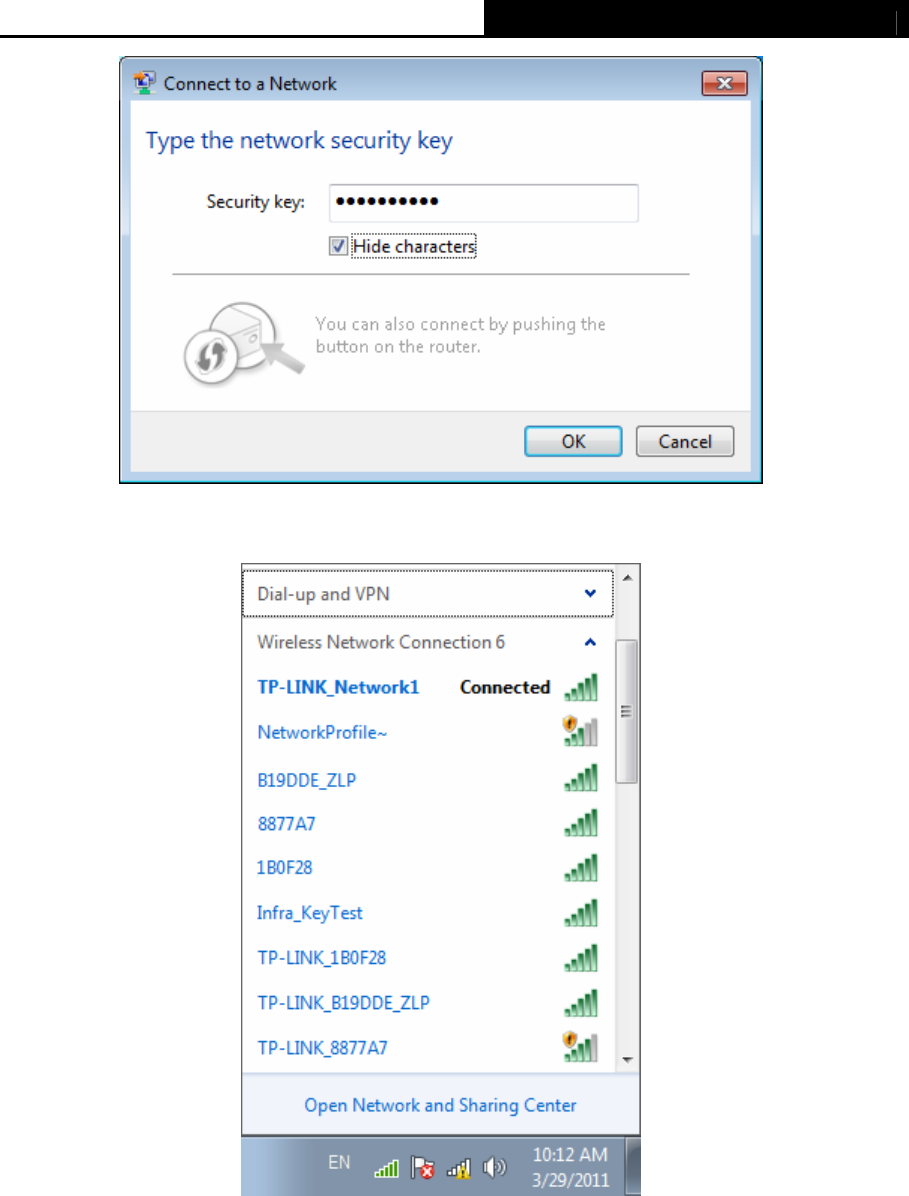
TL-WDN3200 N600 Wireless Dual Band USB Adapter
18
Figure 3-18
3. You have successfully connected to the network and can surf the Internet now.
Figure 3-19
3.3.2 In Windows Vista
Windows Vista users may use the built-in wireless utility. Follow the steps below.
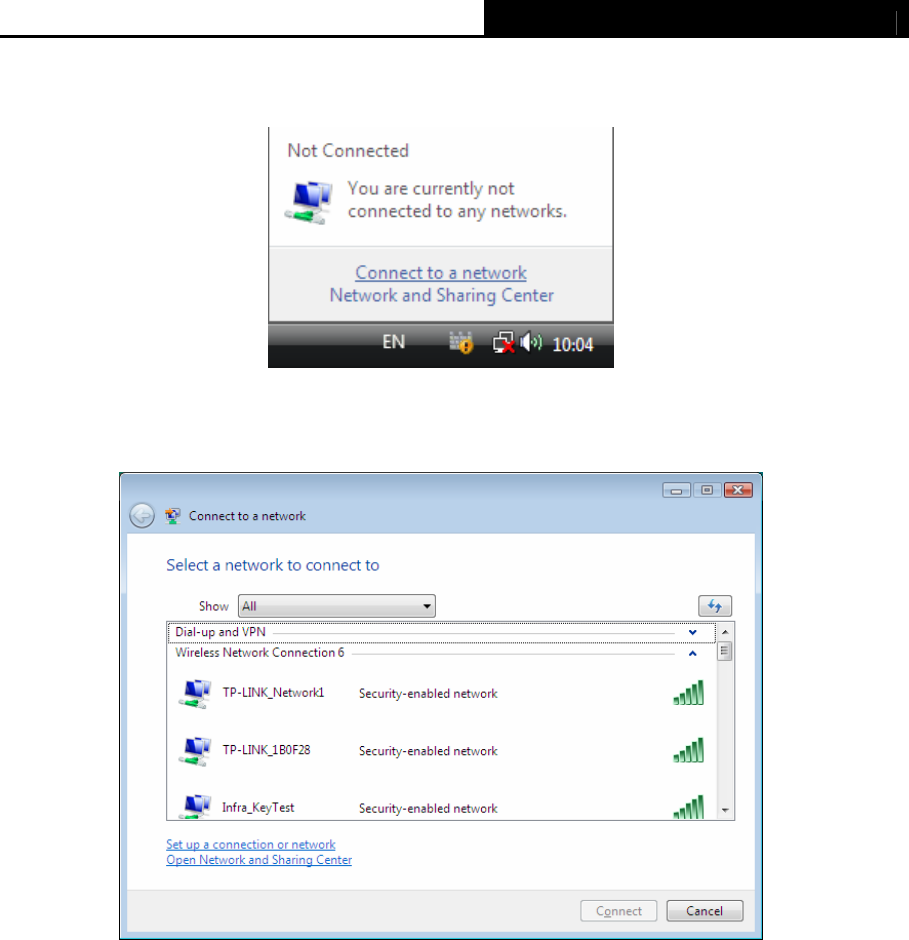
TL-WDN3200 N600 Wireless Dual Band USB Adapter
19
1. Open the wireless utility by right-clicking on the wireless computer icon in your system tray
as shown in the figure below. Select Connect to a network.
Figure 3-20
2. The utility will display any available wireless networks in your area. Select the wireless
network you would like to connect and then click Connect.
Figure 3-21
3. If the network you would like to connect is security-enabled, enter the same security key or
passphrase that is on your router. If the network to be connected is not secure, the
connection will be built without entering a key.
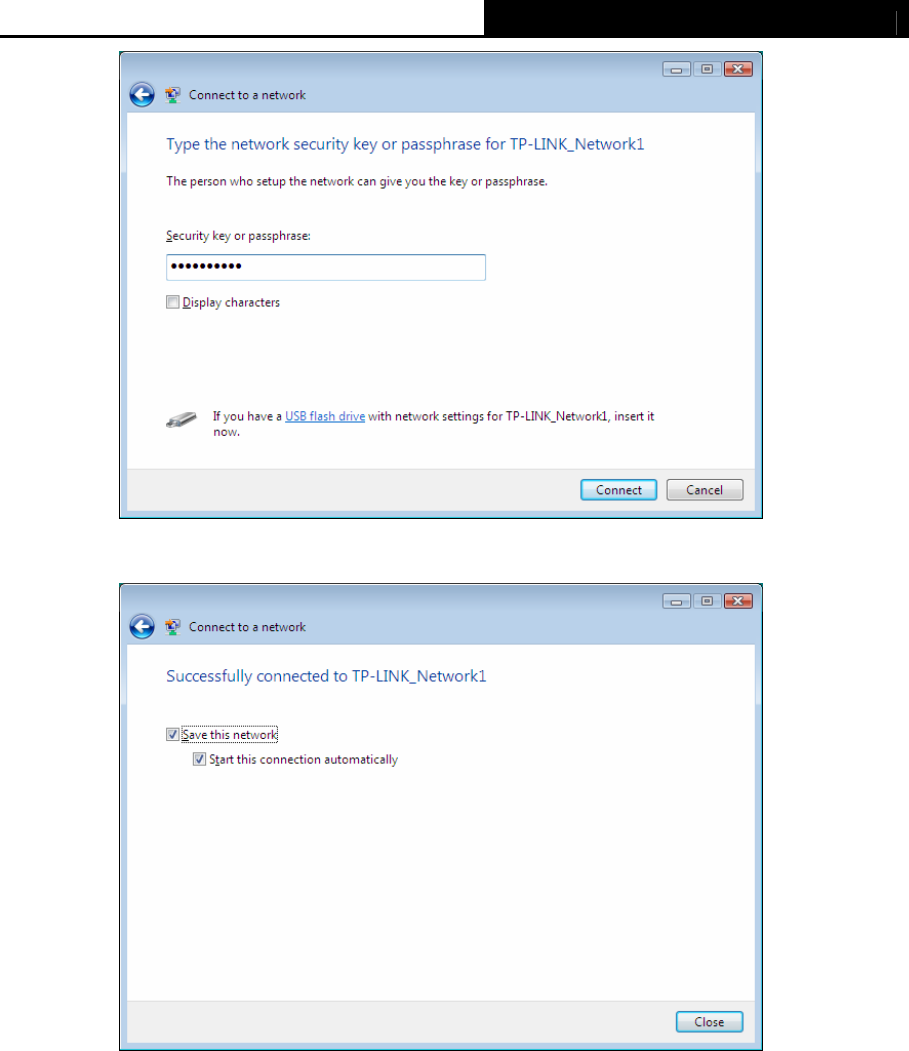
TL-WDN3200 N600 Wireless Dual Band USB Adapter
20
Figure 3-22
4. You have successfully connected to the network now and can surf the Internet now.
Figure 3-23
3.3.3 In Windows XP
Windows XP users may use the built-in wireless utility. Follow the steps below.
1. Right-click on the utility icon in your system tray (lower-right corner). Select Switch to
TP-LINK Wireless configuration Utility.
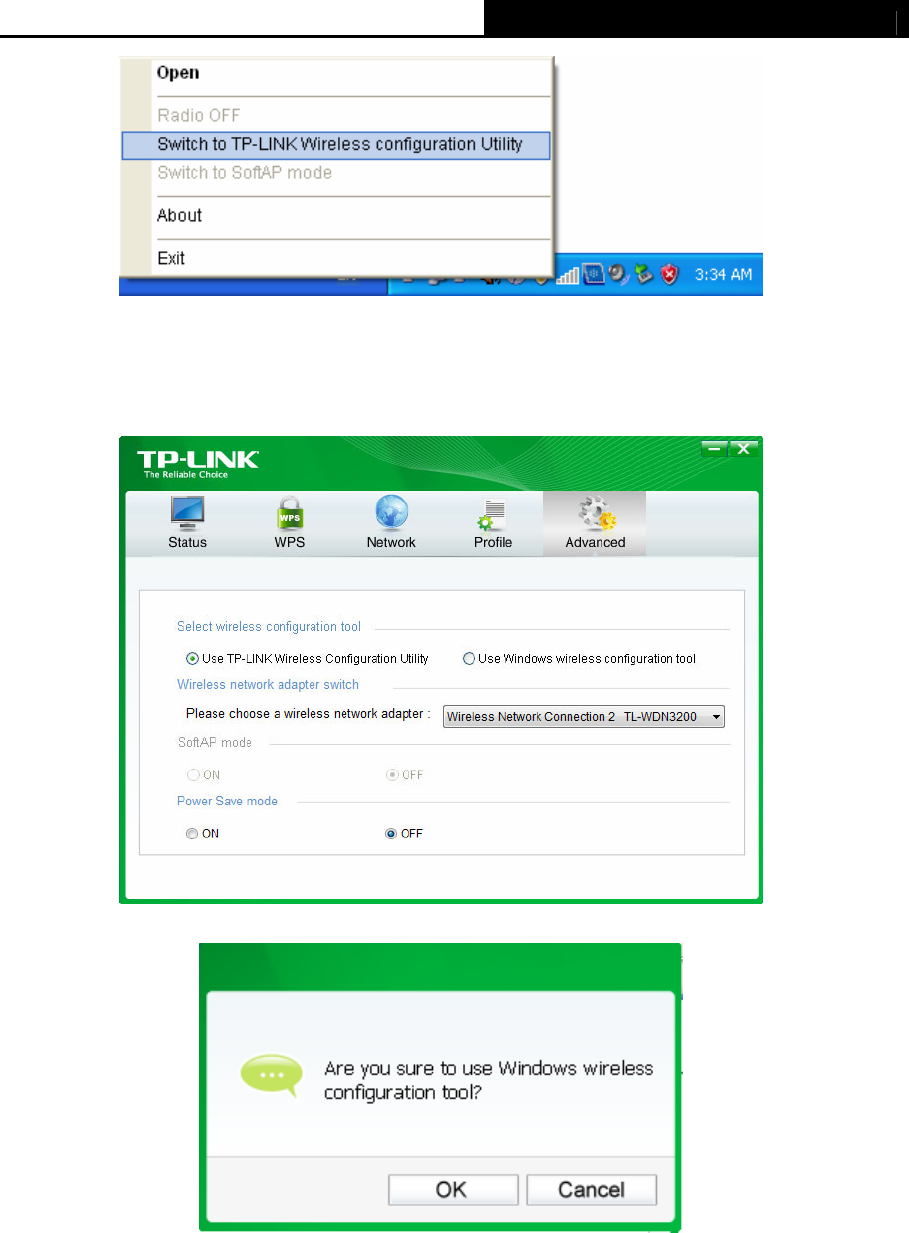
TL-WDN3200 N600 Wireless Dual Band USB Adapter
21
Figure 3-24
Or double-click the utility icon to load the utility configuration page. Click Advanced in the
tools section and then select Use Windows wireless configuration tool in the figure
shown below. Click OK when Figure 3-26 appears to continue.
Figure 3-25
Figure 3-26
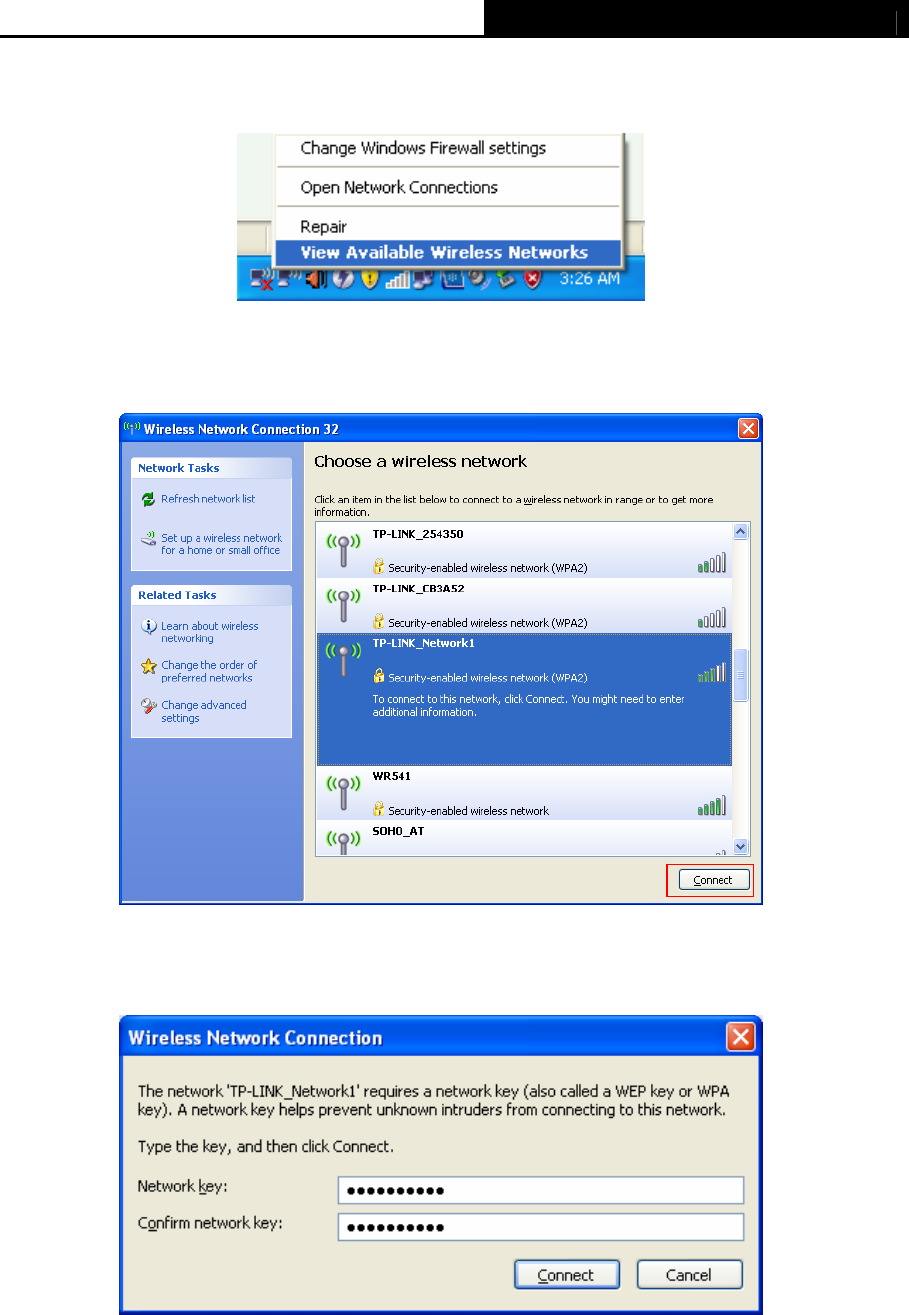
TL-WDN3200 N600 Wireless Dual Band USB Adapter
22
2. Right-click on the wireless computer icon in your system tray (lower-right corner). Select
View Available Wireless Networks.
Figure 3-27
3. The utility will display any available wireless networks in your area. Click on a network
(displayed using the SSID) and click the Connect button.
Figure 3-28
4. If the network is security-enabled, you will be prompted to enter the key as shown below. If
not, you will connect to the network directly without entering a key.
Figure 3-29
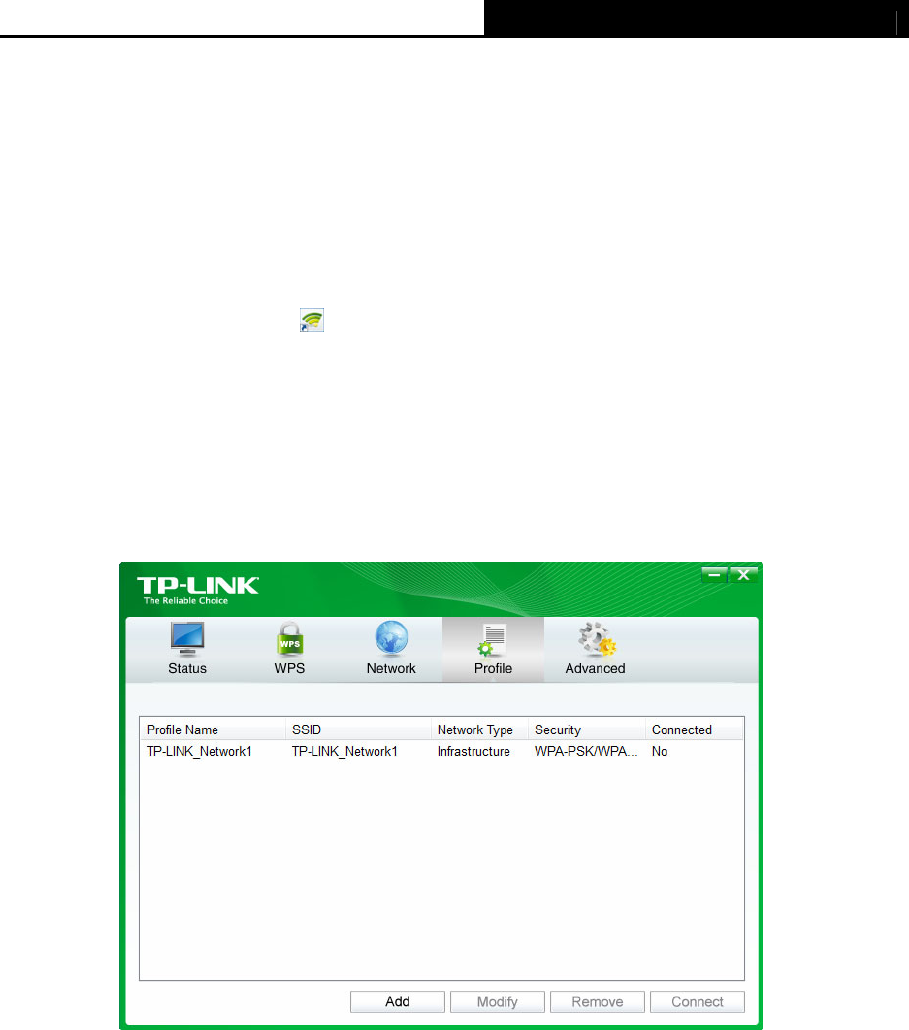
TL-WDN3200 N600 Wireless Dual Band USB Adapter
23
Chapter 4 Management
This section will show you how to configure your TL-WDN3200 adapter using the TP-LINK
Wireless Configuration Utility (TWCU).
The TL-WDN3200 adapter uses the TP-LINK Wireless Configuration Utility as the management
software. The utility provides users with an easy interface to change any settings related to the
adapter. Double-clicking on the icon on your desktop will start the utility.
4.1 Profile
Your wireless networks may vary in different places like home, office or coffee shop. With
Profile management, you can easily save and manage various networks to be connected,
saving you the trouble of having to repeat the same configurations. Click Profile in the tools
section, the following page will appear.
Figure 4-1
4.1.1 Add a profile
To add a profile, click the Add button on the bottom of the screen. Then the configuration
window will appear.
4.1.1.1. Add a profile in Infrastructure mode
If you are connecting to a wireless router or access point, select Infrastructure as the Network
Type in the screen that appears and follow the instructions below to finish the setting.
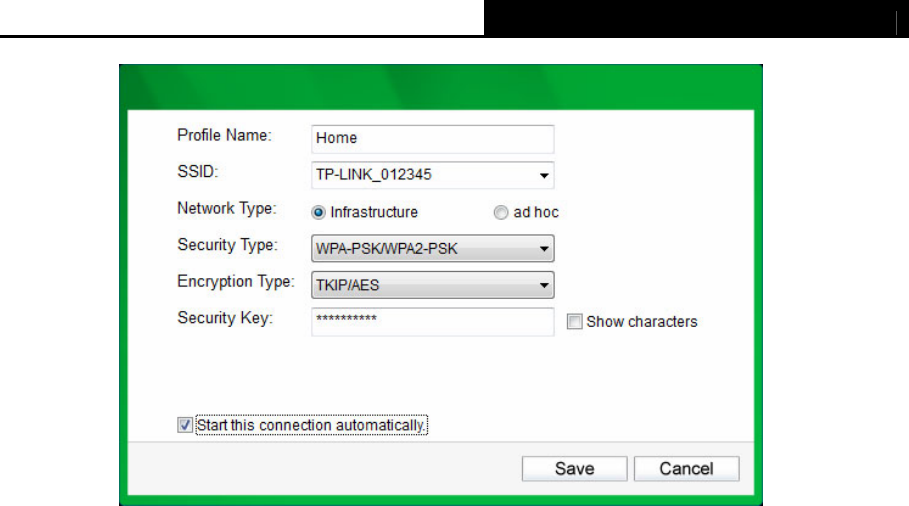
TL-WDN3200 N600 Wireless Dual Band USB Adapter
24
Figure 4-2
The following items can be found on the screen.
¾ Profile Name: Enter a name for your profile e.g. Home, Office, Coffee Shop. The same
name is not allowed. Please also note that no space is allowed between words.
¾ SSID: Select the target network from the drop-down list.
¾ Network Type: Select the network type. If you are connecting to a wireless router or
access point, select Infrastructure. If you are connecting to another wireless client such as
an adapter, select ad hoc.
¾ Security Type: Select the security type from the list. Four options are available:
WPA-PSK/WPA2-PSK, WPA/WPA2, WEP and None. The security type should be the
same as on your router or access point, otherwise, you will not be able to build a successful
connection.
WPA-PSK/WPA2-PSK uses a passphrase or key to authenticate your wireless connection.
The key must be the exact same key entered on your wireless router or access point.
None stands for no security. It is recommended to enable WPA-PSK/WPA2-PSK on your
wireless router or access point before configuring your wireless adapter.
¾ Encryption Type: From the drop-down menu, select the encryption type that is the same
as on your router or access point.
¾ Security Key: Enter the passphrase exactly as it is on your wireless router or access point.
Click the Show characters box to see the passphrase. Unchecking it will hide it.
¾ Start this connection automatically: Check this box to automatically connect to this
network next time.
¾ Save: Click Save to save your settings.
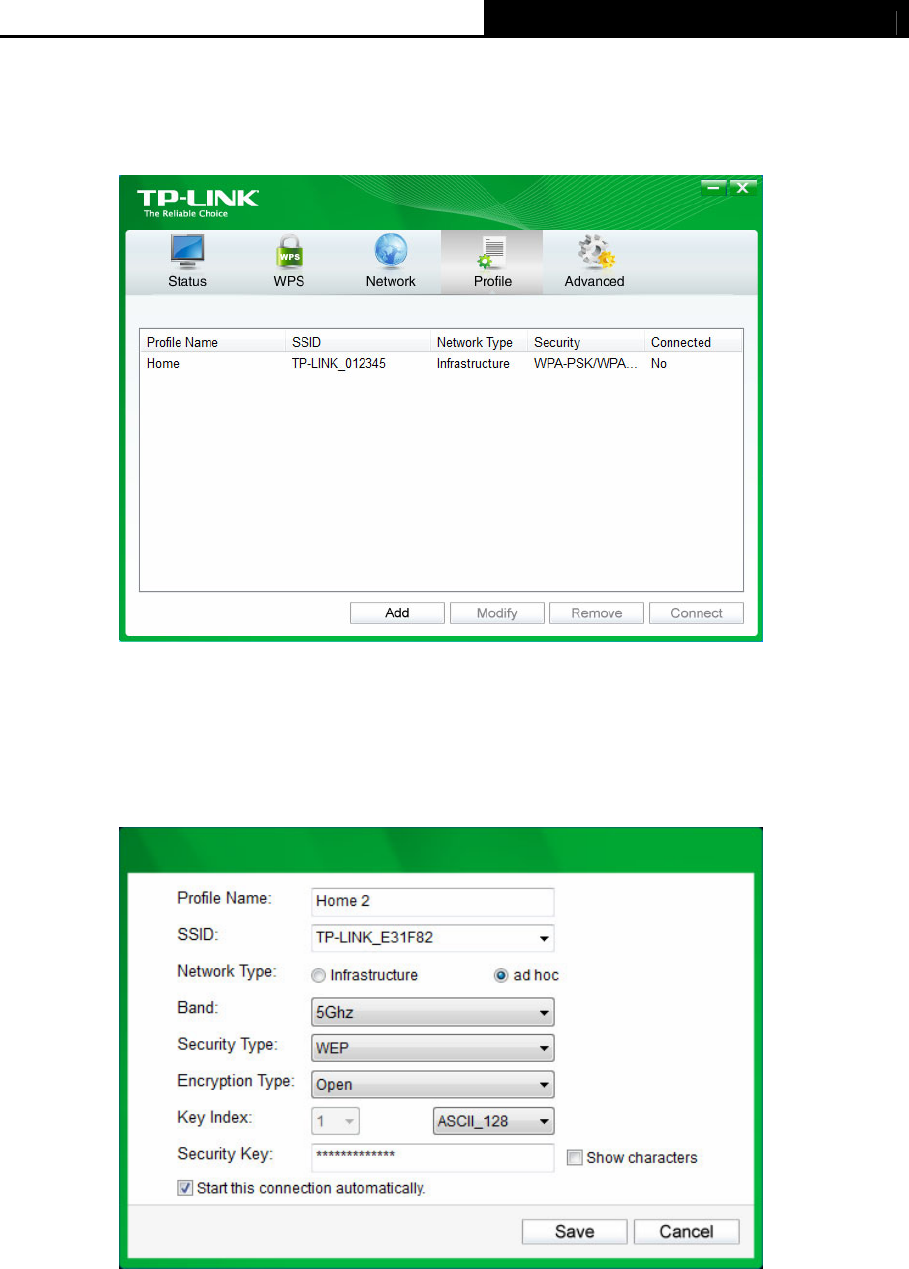
TL-WDN3200 N600 Wireless Dual Band USB Adapter
25
Complete the above settings, the Profile page should looks like the following figure. To connect
to a desired network, just highlight the network you would like to connect to and click the
Connect button on the bottom of the window.
Figure 4-3
4.1.1.2. Add a profile in ad hoc mode
If you are connecting to another wireless client such as an adapter, select ad hoc as the
Network Type in the screen that appears and follow the instructions below to finish the setting.
Figure 4-4
The following items can be found on the screen.
¾ Profile Name: Enter a name for your profile e.g. Home, Office, Coffee Shop. The same
name is not allowed. Please also note that no space is allowed between words.
¾ SSID: Select the target network from the drop-down list.

TL-WDN3200 N600 Wireless Dual Band USB Adapter
26
¾ Network Type: Select the network type. If you are connecting to a wireless router or
access point, select Infrastructure. If you are connecting to another wireless client such as
an adapter, select ad hoc.
¾ Band: This item determines which operating frequency will be used. Two options are
available: 2.4Ghz and 5Ghz. It is recommended that your computers and devices running
video and voice applications use the 5Ghz band, while your guest access and computers
that are only browsing the web use the 2.4Ghz band.
z 2.4Ghz - You can use the 2.4GHz band to connect to many classic wireless devices
like gaming consoles, laptops, DVRs, ect.
z 5Ghz - This band is less crowded and is used for time-sensitive music, video
streaming or gaming. Using this band can avoid interference with 2.4GHz networks or
noisy devices like cordless phones and microwave ovens.
¾ Security Type: Select the security type from the list. Two options are available: WEP and
None. None stands for no security. It is recommended that you select WEP to secure your
wireless network.
¾ Encryption Type: If you select None as the Security Type, the Encryption Type will be
None accordingly. If you select WEP as the Security Type, the Encryption Type will be
Open.
¾ Key Index: You can select ASCII or Hexadecimal format on the right. ASCII format stands
for any combination of keyboard characters in the specified length. Hexadecimal format
stands for any combination of hexadecimal digits (0-9, a-f, A-F) in the specified length.
• For 64-bit encryption - You can enter 10 hexadecimal digits (any combination of 0-9,
a-f, A-F, zero key is not permitted) or 5 ASCII characters.
• For 128-bit encryption - You can enter 26 hexadecimal digits (any combination of 0-9,
a-f, A-F, zero key is not permitted) or 13 ASCII characters.
¾ Security Key: Enter the passphrase. Click the Show characters box to see the
passphrase. Unchecking it will hide it.
¾ Start this connection automatically: Check this box to automatically connect to this
network next time.
¾ Save: Click Save to save your settings.
Complete the above settings, the Profile page should looks like the following figure. To connect
to a desired network, just highlight the network you would like to connect to and click the
Connect button on the bottom of the window.
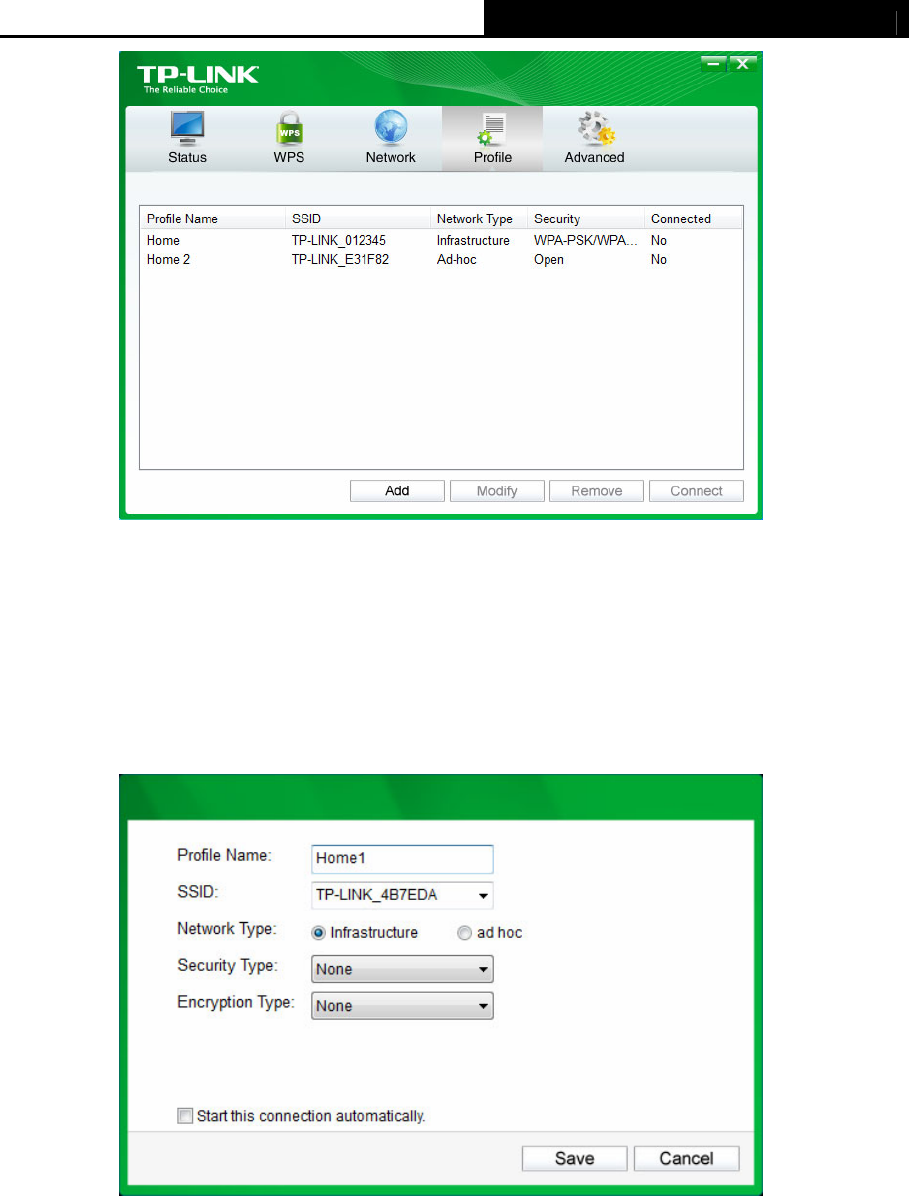
TL-WDN3200 N600 Wireless Dual Band USB Adapter
27
Figure 4-5
4.1.2 Modify a profile
y clicking the Modify button from the Profile page. For You may edit an existing profile b
instance, you may like to change the profile name from Home to Home1 or you may want to
specify another SSID for profile Home. After all the changes, click Save to make the changes
take effect.
Figure 4-6
4.1.3 Delete a profile
ghlight the profile name and click Remove on the bottom of the To delete an existing profile, hi
screen or press the Delete button on your keyboard. When the following figure appears, click
OK to continue.
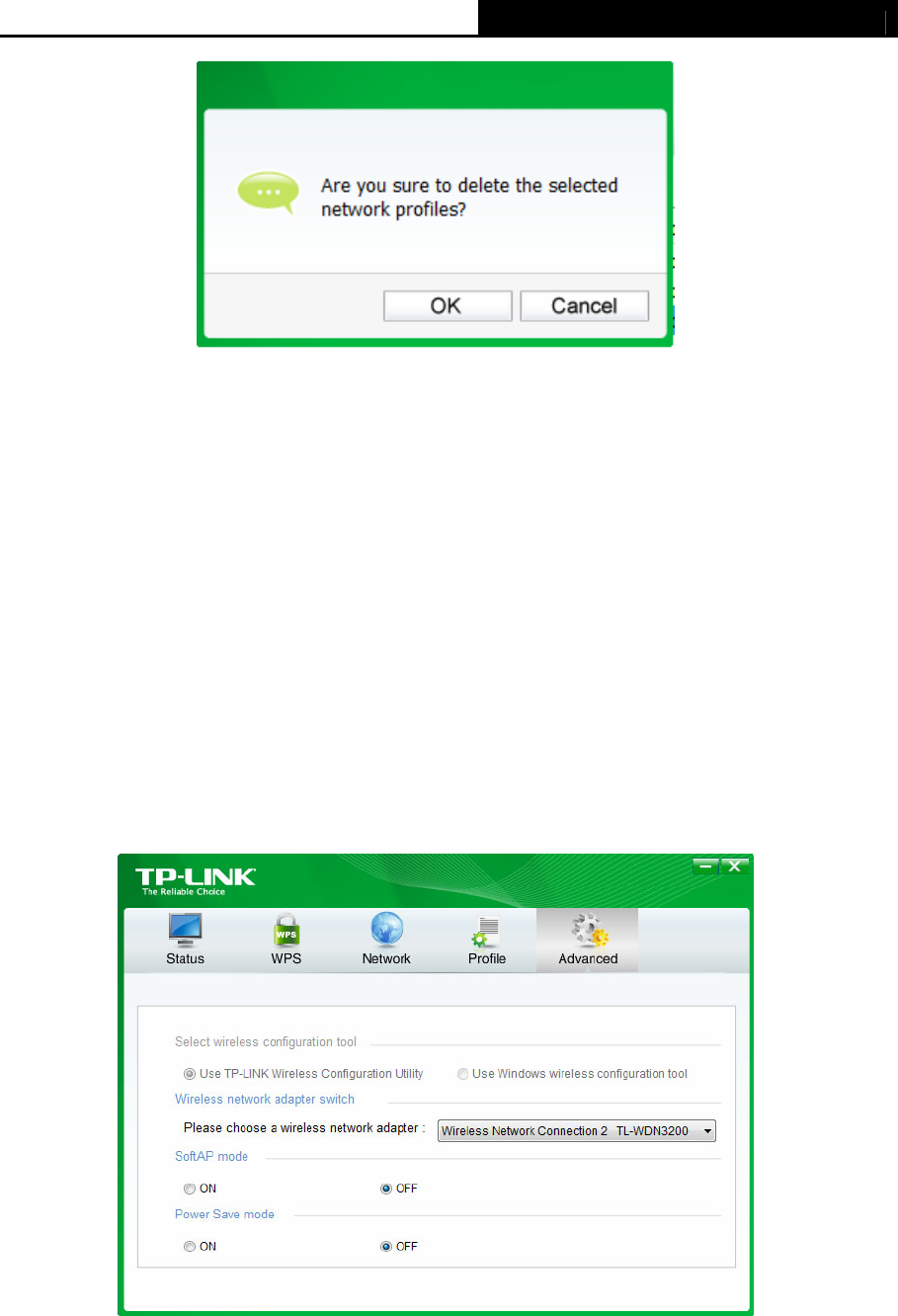
TL-WDN3200 N600 Wireless Dual Band USB Adapter
28
Figure 4-7
4.2 Advanced
The following configurations can be made on the Advanced page:
1) To select wireless configuration tool.
Here you can decide which tool to use, either the TP-LINK Configuration Utility or the
Windows wireless configuration tool. This option is available only in Windows XP.
2) To switch to another wireless network adapter.
Here you can switch to another adapter installed in your computer. The adapters
successfully installed in your computer will be listed in the drop-down menu if the adapters
are supported by this utility.
3) To switch to SoftAP mode.
Once enabled, the adapter will be able to work as an AP.
4) To change the power save mode. The default option is OFF.
Figure 4-8
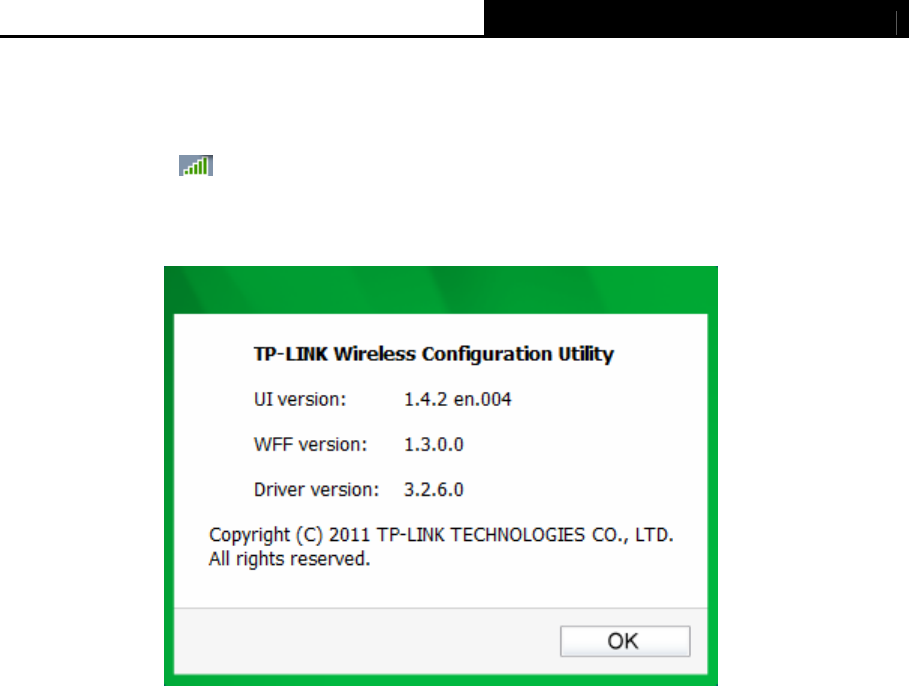
TL-WDN3200 N600 Wireless Dual Band USB Adapter
29
4.3 About
The About screen gives you information about the Driver and Utility versions of the adapter.
Right-click on the icon in your system tray and select About from the list. The actual
UI/WFF/Driver version may differ from that in the figure below. Please refer to the actual
interface of the product.
Figure 4-9
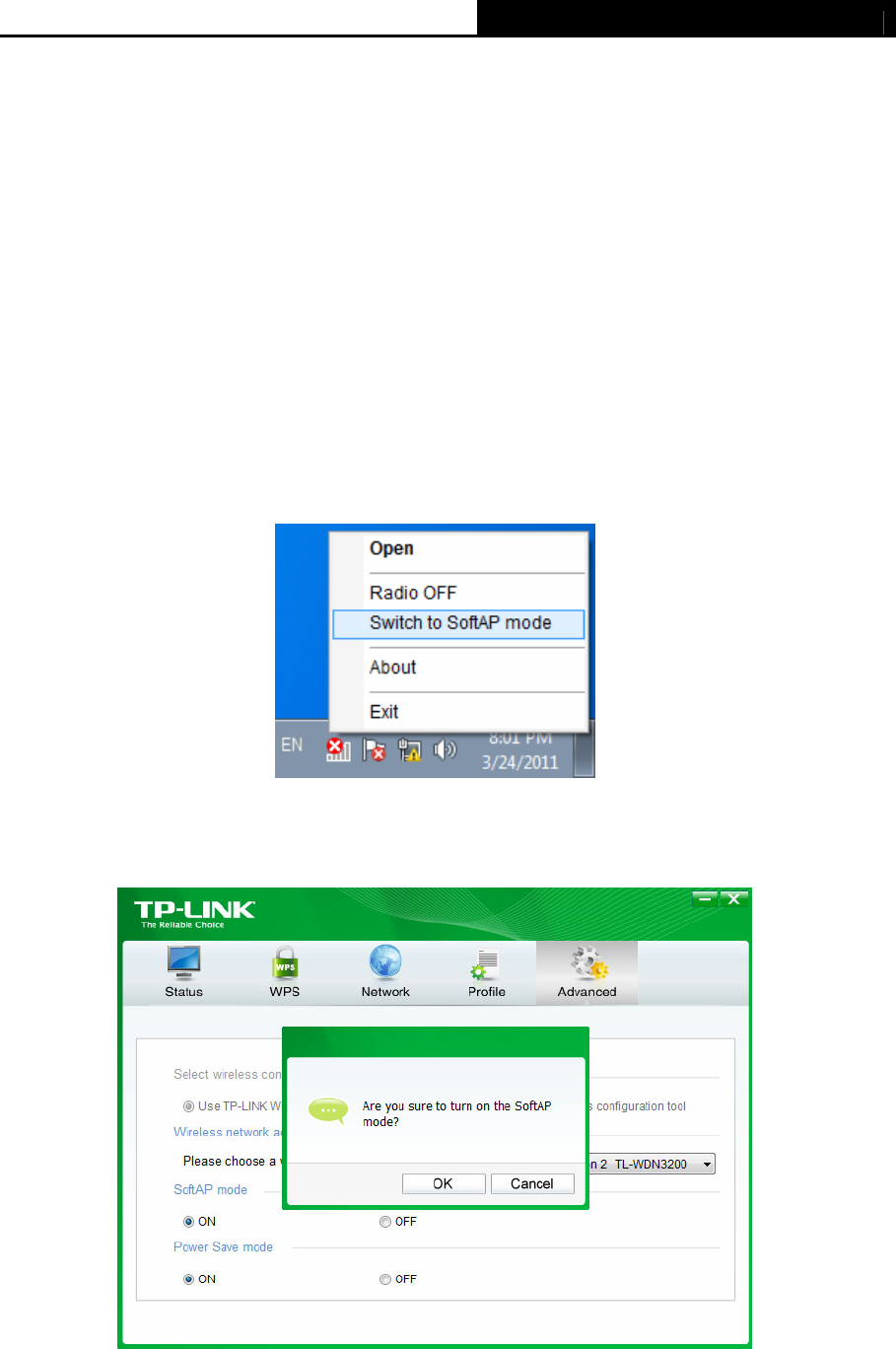
TL-WDN3200 N600 Wireless Dual Band USB Adapter
30
Chapter 5 AP Mode
In Soft AP mode, the adapter will work as an AP. Suppose that only one computer in your
house can access the Internet for various reasons like only one WLAN port is available on your
wired broadband router, however, other wireless-capable devices also want to share the
Internet. Then the adapter can be configured as an AP under the Soft AP mode, saving you the
trouble of having to get a separate access point or a router.
With this feature, a computer can use a single physical wireless adapter to connect as a client
to a hardware access point while at the same time acting as a software AP allowing other
wireless-capable devices to connect to it.
To switch to this mode, right-click on the utility icon in your system tray and select Switch to
SoftAP mode.
Figure 5-1
Or from the Advanced page of the utility, tick ON under the SoftAP mode as shown in the
following figure. Click OK when prompted to confirm the setting.
Figure 5-2
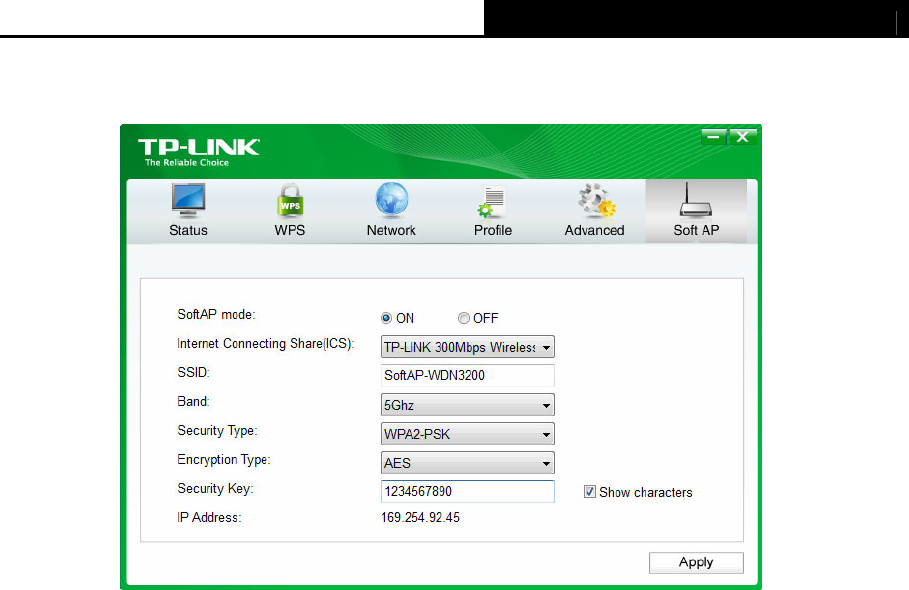
TL-WDN3200 N600 Wireless Dual Band USB Adapter
31
The Soft AP icon should then appear beside Advanced icon in the utility. Please note that the
Band option is available only in Windows XP and Windows Vista.
Figure 5-3
¾ SoftAP mode: Select to enable or disable the function.
¾ Internet Connecting Share(ICS): Specify a connection through which devices connected
to your AP can access the Internet. The system will automatically search for all the
available connections in your computer and display them in the drop-down menu.
¾ SSID: Enter the name for your softAP (for example, Jone) so that others can know which
AP is yours when trying to connect to it. The default name (SSID) is “SoftAP”.
¾ Band: This item determines which operating frequency will be used. Two options are
available: 2.4Ghz and 5Ghz. It is recommended that your computers and devices running
video and voice applications use the 5Ghz band, while your guest access and computers
that are only browsing the web use the 2.4Ghz band.
z 2.4Ghz - You can use the 2.4GHz band to connect to many classic wireless devices
like gaming consoles, laptops, DVRs, ect.
z 5Ghz - This band is less crowded and is used for time-sensitive music, video
streaming or gaming. Using this band can avoid interference with 2.4GHz networks or
noisy devices like cordless phones and microwave ovens.
¾ Security Type: The security type here is set to be WPA2-PSK which is based on 802.11i
and uses Advanced Encryption Standard instead of TKIP. It was designed to improve the
security features of WEP. WPA2-PSK uses a passphrase or key to authenticate your
wireless connection. You needn’t make any configuration here.
¾ Encryption Type: The encryption type here is set to be AES.
¾ Security Key: Enter the Key in the field to make your AP security enabled. It is
recommended that you specify another key instead of the default key 12345678. Only by

TL-WDN3200 N600 Wireless Dual Band USB Adapter
32
entering the corresponding key can other computers establish a successful connection with
your AP.
¾ IP Address: Here displays the IP address of the SoftAP.
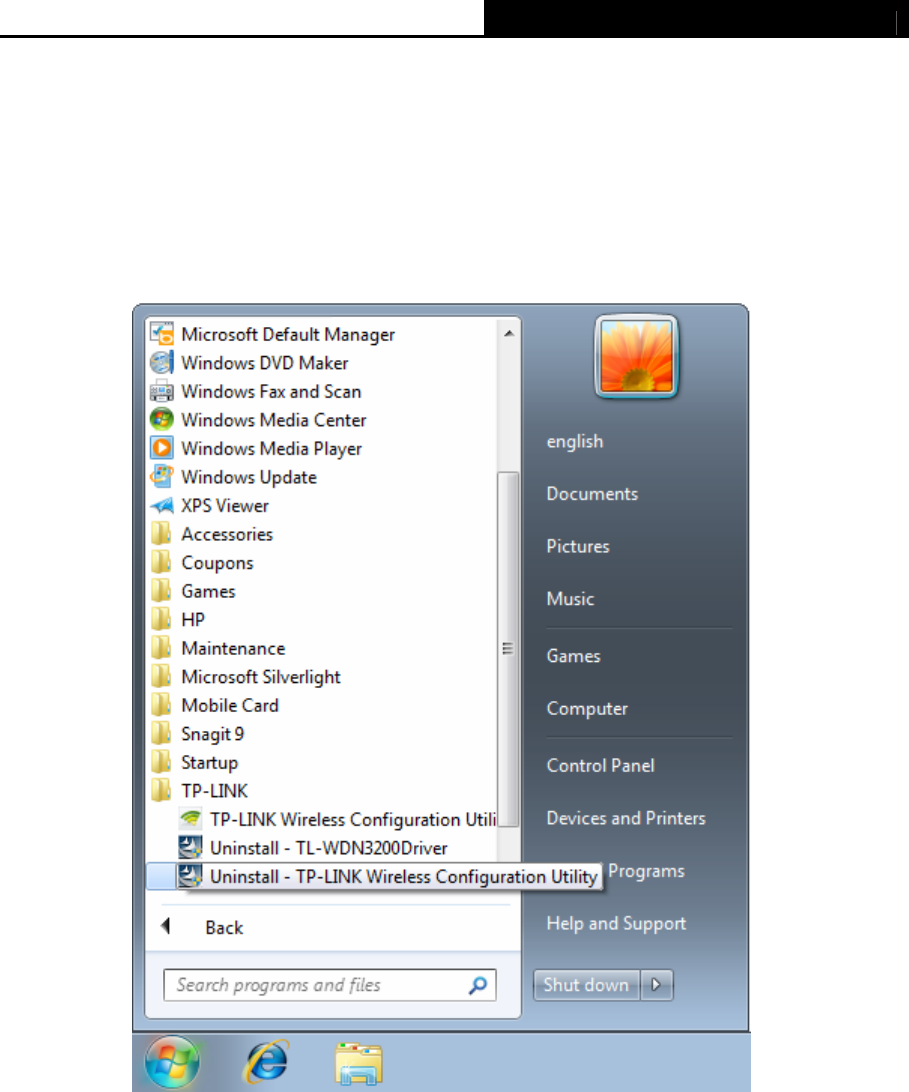
TL-WDN3200 N600 Wireless Dual Band USB Adapter
33
Chapter 6 Uninstall Software
6.1 Uninstall the utility software from your PC
1. On the Windows taskbar, click the Start button, click All programsÆTP-LINK, and then
click Uninstall-TP-LINK Wireless Configuration Utility.
2. The following screen will appear.
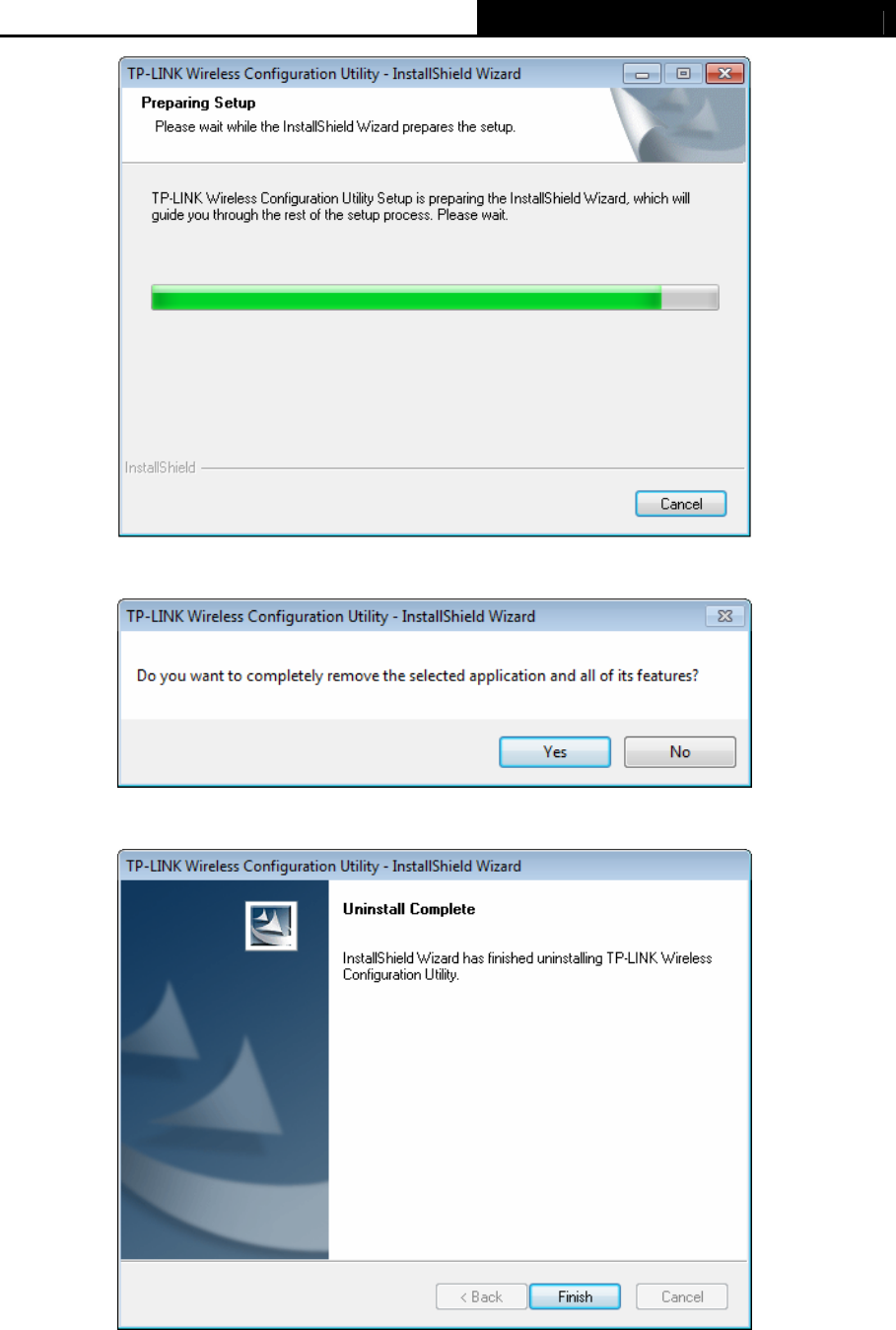
TL-WDN3200 N600 Wireless Dual Band USB Adapter
34
3. Click Yes.
4. Click Finish.
6.2 Uninstall the driver software from your PC
1. On the Windows taskbar, click the Start button, and then click All programsÆTP-LINK.
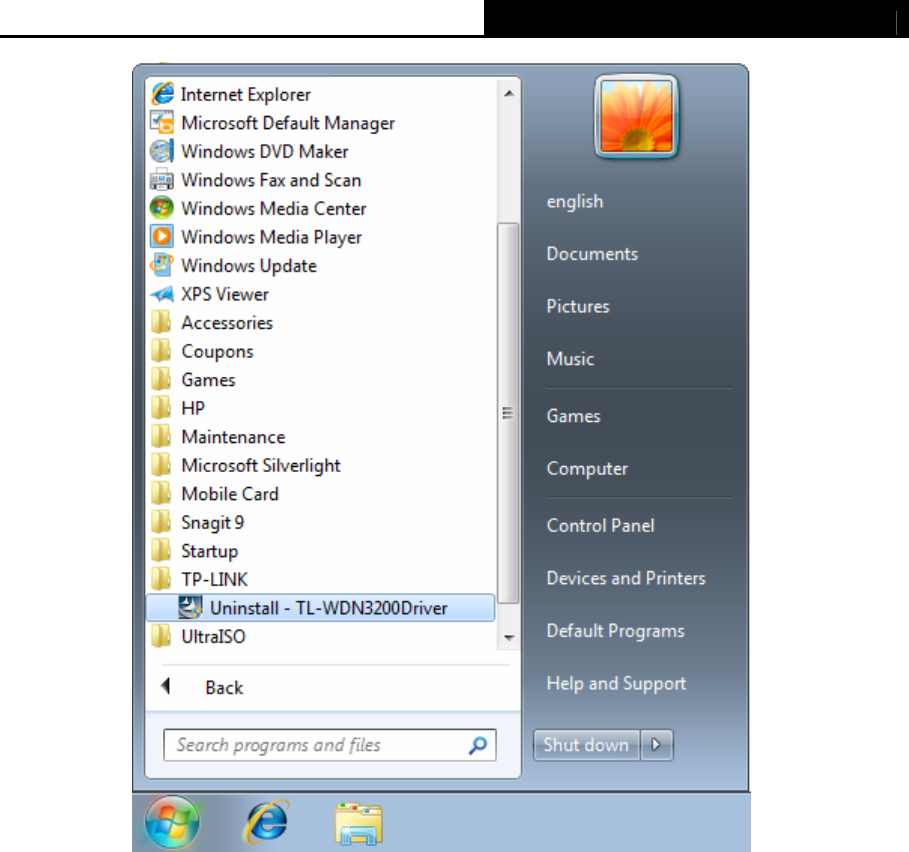
TL-WDN3200 N600 Wireless Dual Band USB Adapter
35
Figure 6-1 Device Manager
2. Click Uninstall - TL-WDN3200 Driver shown in above figure, the system will uninstall the
driver software of the adapter from your PC.

TL-WDN3200 N600 Wireless Dual Band USB Adapter
36
Appendix A: Specifications
Normal
Interface USB 2.0 Interface
Standards IEEE802.11a, IEEE 802.11b, IEEE 802.11n, IEEE 802.11g
Operating System Windows 7, Windows Vista, Windows XP
Throughput 300Mbps (Maximal)
Radio Data Rate
11a: 6/9/12/18/24/36/48/54Mbps
11b: 1/2/5.5/11Mbps
11g: 6/9/12/18/24/36/48/54Mbps
11n: Up to 300Mbps
Modulation
11a:OFDM
11b:CCK,QPSK,BPSK
11g:OFDM
11n: QPSK,BPSK,16-QAM,64-QAM
Media Access Protocol CSMA/CA with ACK
Data Security WPA-PSK/WPA2-PSK, WPA/WPA2, WEP, TKIP/AES
Frequency* 2.4~2.4835GHz,5.18~5.24GHz,5.745~5.825GHz
Spread Spectrum Direct Sequence Spread Spectrum (DSSS)
Safety & Emissions FCC, CE
Environmental and Physical
Working Temperature 0℃~40 (32℃~104℉ ℉)
Working Humidity 10% ~ 90% RH, Non-condensing
Storage Temperature -40~70 (℃ ℃ -40 ~158℉)℉
Storage Humidity 5% ~ 90% RH, Non-condensing
* 1. Only 2.412GHz~2.462GHz is allowed to be used in USA, which means only channel 1~11 is
available for American users to choose.
2. Rules on the use of 5GHz band channels may vary according to different national laws.
3. 5.15~5.25GHz is prohibited in Taiwan, so firmware for Taiwan will not open this band and please
don not use this band if you use our products in Taiwan.
Antenna Gain 0.76dBi@2.4GHz, 3.24dBi@5GHz
4. The antenna is PIFA printed type.
.
5. Band 5.22~5.24GHz is closed for Canada firmware.

TL-WDN3200 N600 Wireless Dual Band USB Adapter
37
Appendix B: Glossary
¾ 802.11a - Specification for wireless networking at 54 Mbps using OFDM modulation and
operating in radio band at 5GHz.
¾ 802.11b - The 802.11b standard specifies a wireless product networking at 11 Mbps using
direct-sequence spread-spectrum (DSSS) technology and operating in the unlicensed radio
spectrum at 2.4GHz, and WEP encryption for security. 802.11b networks are also referred to
as Wi-Fi networks.
¾ 802.11g - specification for wireless networking at 54 Mbps using direct-sequence
spread-spectrum (DSSS) technology, using OFDM modulation and operating in the
unlicensed radio spectrum at 2.4GHz, and backward compatibility with IEEE 802.11b devices,
and WEP encryption for security.
¾ 802.11n - 802.11n builds upon previous 802.11 standards by adding MIMO (multiple-input
multiple-output). MIMO uses multiple transmitter and receiver antennas to allow for increased
data throughput via spatial multiplexing and increased range by exploiting the spatial diversity,
perhaps through coding schemes like Alamouti coding. The Enhanced Wireless Consortium
(EWC) was formed to help accelerate the IEEE 802.11n development process and promote a
technology specification for interoperability of next-generation wireless local area networking
(WLAN) products.
¾ Ad hoc Network - An ad hoc network is a group of computers, each with a Wireless Adapter,
connected as an independent 802.11 wireless LAN. Ad hoc wireless computers operate on a
peer-to-peer basis, communicating directly with each other without the use of an access point.
Ad hoc mode is also referred to as an Independent Basic Service Set (IBSS) or as
peer-to-peer mode, and is useful at a departmental scale or SOHO operation.
¾ DSSS - (Direct-Sequence Spread Spectrum) - DSSS generates a redundant bit pattern for all
data transmitted. This bit pattern is called a chip (or chipping code). Even if one or more bits
in the chip are damaged during transmission, statistical techniques embedded in the receiver
can recover the original data without the need of retransmission. To an unintended receiver,
DSSS appears as low power wideband noise and is rejected (ignored) by most narrowband
receivers. However, to an intended receiver (i.e. another wireless LAN endpoint), the DSSS
signal is recognized as the only valid signal, and interference is inherently rejected (ignored).
¾ FHSS - (Frequency Hopping Spread Spectrum) - FHSS continuously changes (hops) the
carrier frequency of a conventional carrier several times per second according to a
pseudo-random set of channels. Because a fixed frequency is not used, and only the
transmitter and receiver know the hop patterns, interception of FHSS is extremely difficult.
¾ Infrastructure Network - An infrastructure network is a group of computers or other devices,
each with a Wireless Adapter, connected as an 802.11 wireless LAN. In infrastructure mode,
the wireless devices communicate with each other and to a wired network by first going
through an access point. An infrastructure wireless network connected to a wired network is
referred to as a Basic Service Set (BSS). A set of two or more BSS in a single network is

TL-WDN3200 N600 Wireless Dual Band USB Adapter
38
referred to as an Extended Service Set (ESS). Infrastructure mode is useful at a corporation
scale, or when it is necessary to connect the wired and wireless networks.
¾ Spread Spectrum - Spread Spectrum technology is a wideband radio frequency technique
developed by the military for use in reliable, secure, mission-critical communications systems.
It is designed to trade off bandwidth efficiency for reliability, integrity, and security. In other
words, more bandwidth is consumed than in the case of narrowband transmission, but the
trade off produces a signal that is, in effect, louder and thus easier to detect, provided that the
receiver knows the parameters of the spread-spectrum signal being broadcast. If a receiver is
not tuned to the right frequency, a spread-spectrum signal looks like background noise.
There are two main alternatives, Direct Sequence Spread Spectrum (DSSS) and Frequency
Hopping Spread Spectrum (FHSS).
¾ SSID - A Service Set Identification is a thirty-two character (maximum) alphanumeric key
identifying a wireless local area network. For the wireless devices in a network to
communicate with each other, all devices must be configured with the same SSID. This is
typically the configuration parameter for a wireless PC card. It corresponds to the ESSID in
the wireless Access Point and to the wireless network name. See also Wireless Network
Name and ESSID.
¾ WEP - (Wired Equivalent Privacy) - A data privacy mechanism based on a 64-bit or 128-bit or
152-bit shared key algorithm, as described in the IEEE 802.11 standard. To gain access to a
WEP network, you must know the key. The key is a string of characters that you create.
When using WEP, you must determine the level of encryption. The type of encryption
determines the key length. 128-bit encryption requires a longer key than 64-bit encryption.
Keys are defined by entering in a string in HEX (hexadecimal - using characters 0-9, A-F) or
ASCII (American Standard Code for Information Interchange – alphanumeric characters)
format. ASCII format is provided so you can enter a string that is easier to remember. The
ASCII string is converted to HEX for use over the network. Four keys can be defined so that
you can change keys easily.
¾ Wi-Fi - A trade name for the 802.11b wireless networking standard, given by the Wireless
Ethernet Compatibility Alliance (WECA, see http://www.wi-fi.net), an industry standards
group promoting interoperability among 802.11b devices.
¾ WLAN - (Wireless Local Area Network) - A group of computers and associated devices
communicate with each other wirelessly, which network serving users are limited in a local
area.
¾ WPA - (Wi-Fi Protected Access) - A wireless security protocol uses TKIP (Temporal Key
Integrity Protocol) encryption, which can be used in conjunction with a RADIUS server.